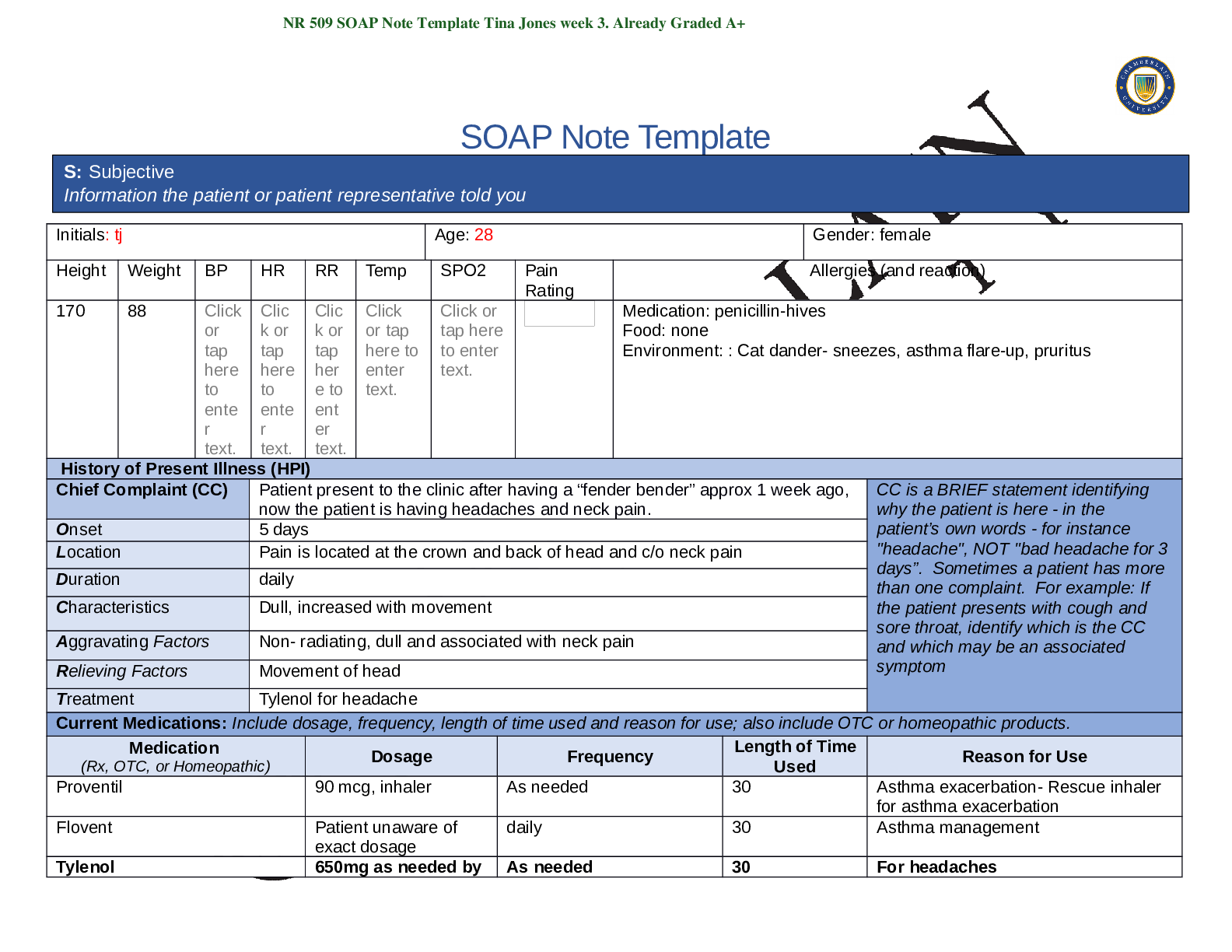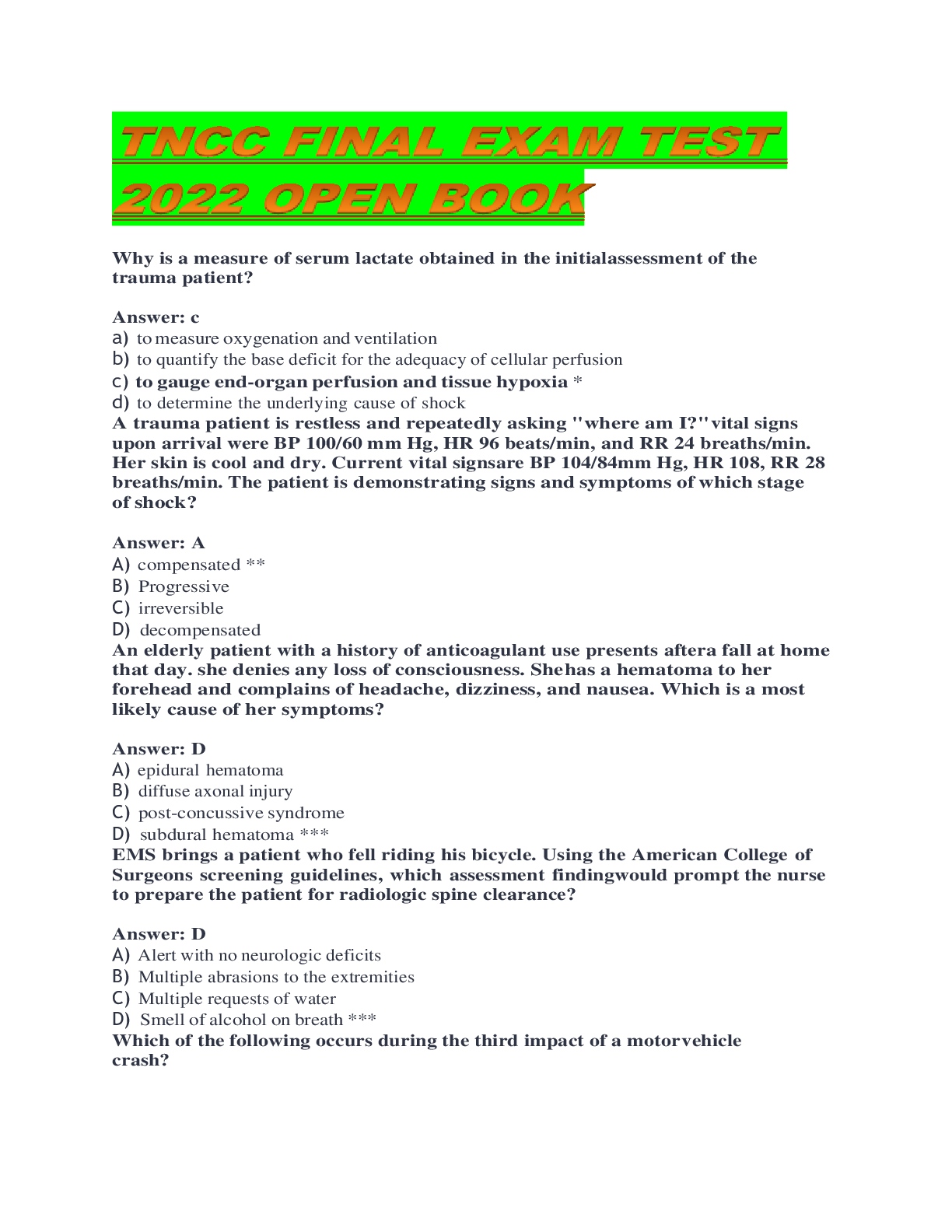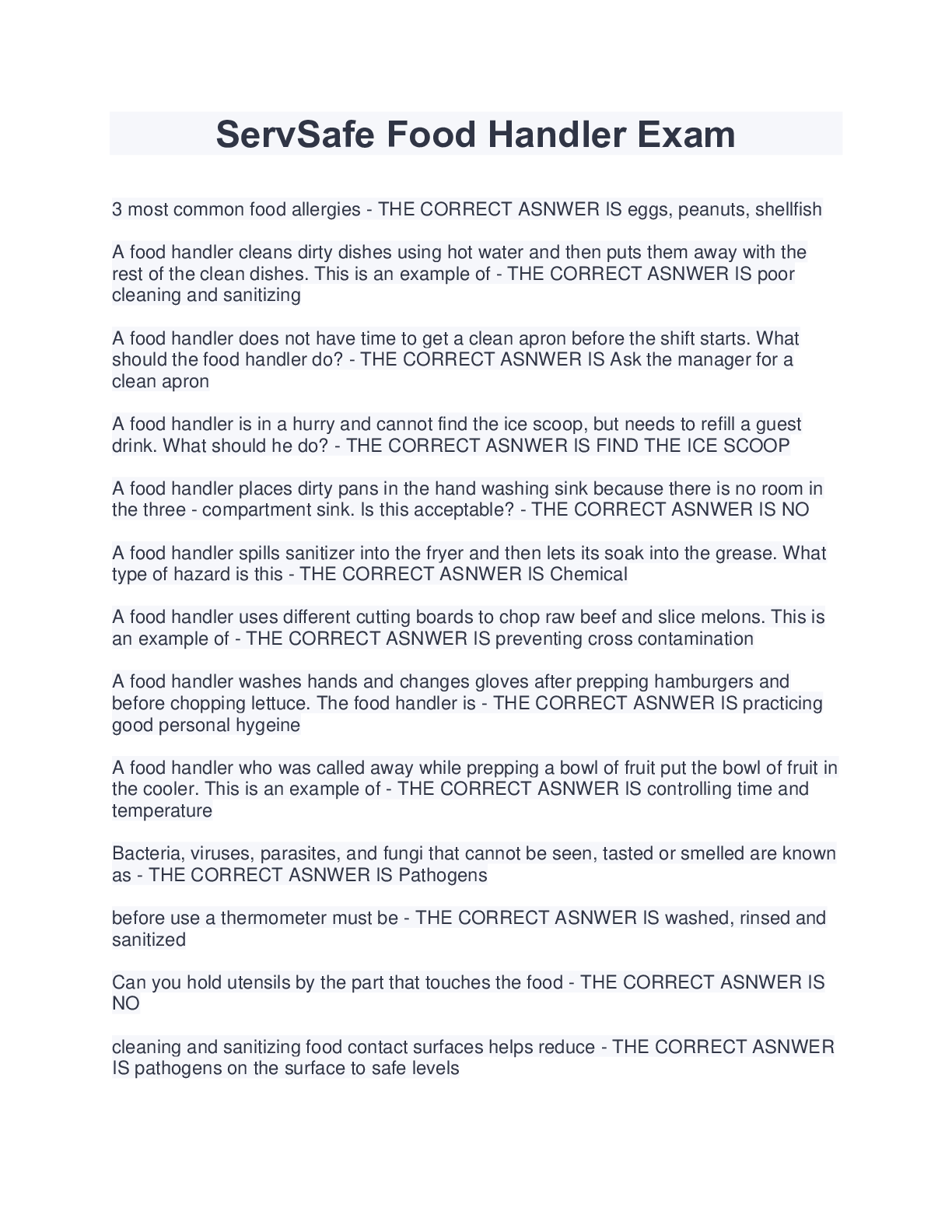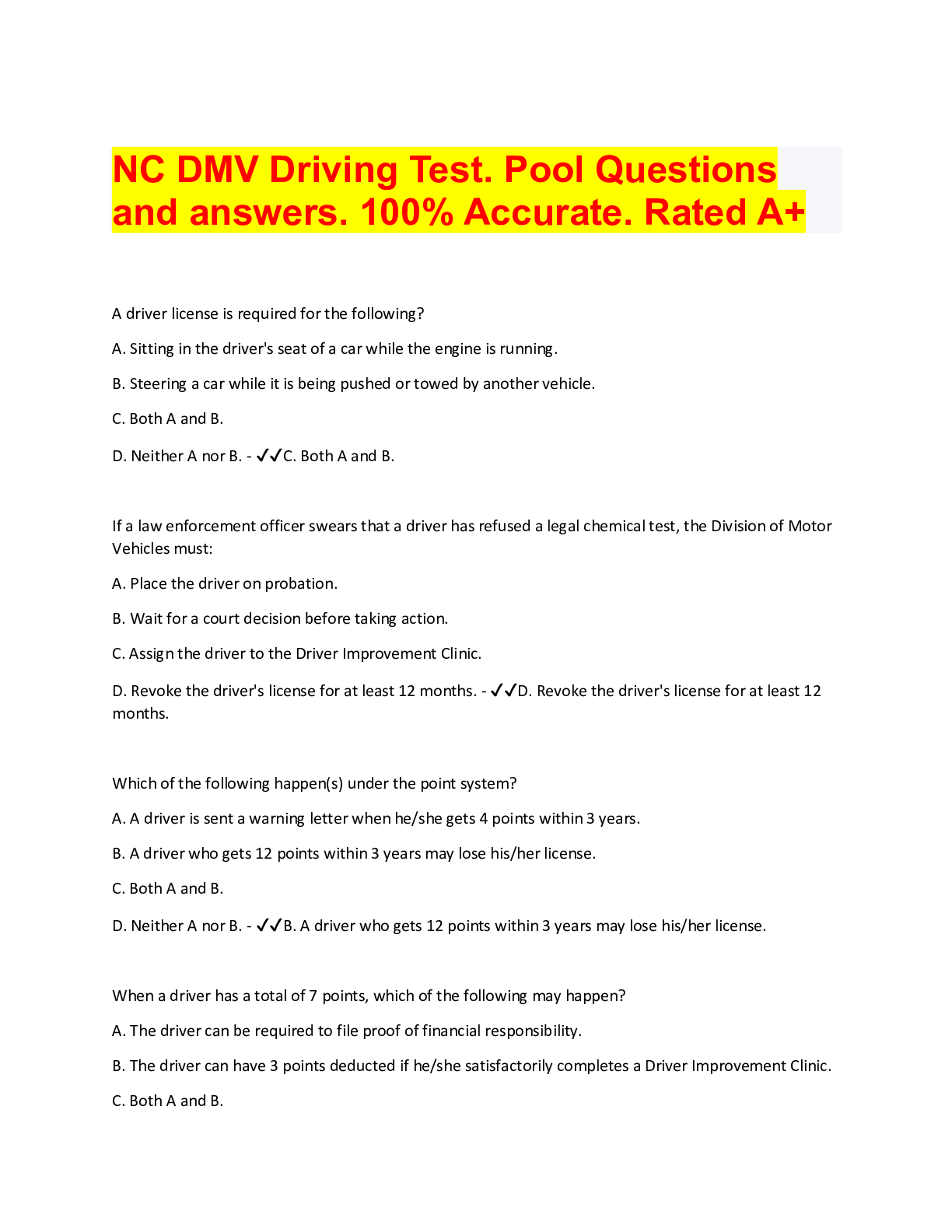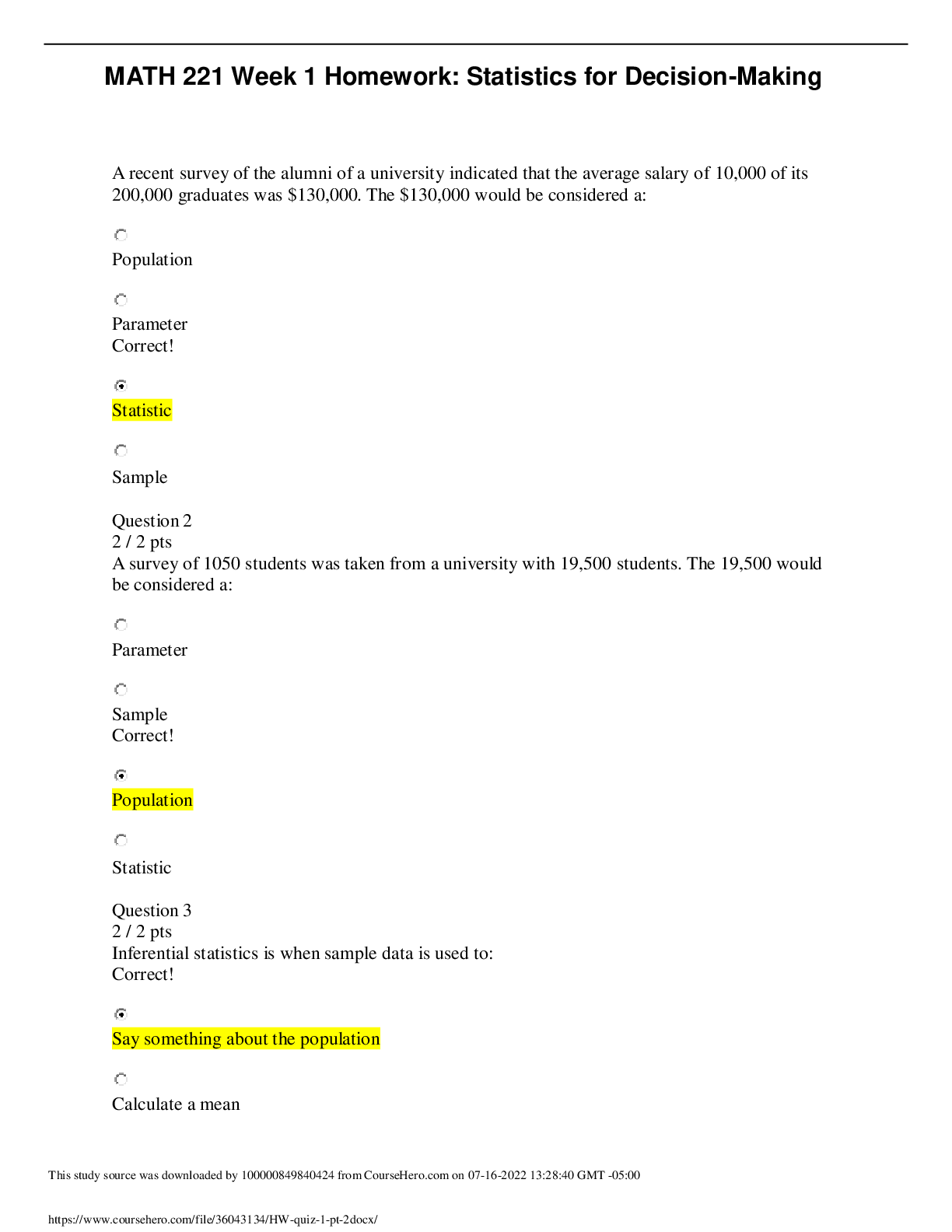*NURSING > EXAM > RN_VATI_Adult_Medical_Surgical_2019 | NURSING 2262 OCR ALREADY GRADED A+ 100% (All)
RN_VATI_Adult_Medical_Surgical_2019 | NURSING 2262 OCR ALREADY GRADED A+ 100%
Document Content and Description Below
• RN VATI Adult Medical Surgical 2019 CLOSE Question 90 loaded rationals provided Question: 90 of 90 A nurse is caring for a client who has atopic dermatitis and a prescription for triamcinolon e oi... ntment. The nurse should assess the client to monitor for which of the following adverse effects? Increased pigmentation Topical glucocorticoid therapy can cause the adverse effect of hypopigmentation. Long-term glucocorticoid therapy can cause hypertrichosis, or excessive hair growth, especially on the facial area. Thinning of the skin and delayed healing are adverse effects of topical glucocorticoid preparations. The client should only apply the ointment to dry patches of the skin because topical steroids can cause atrophy of the dermis and epidermis, which can result in thinning of the skin. Increased sensitivity to the sun The nurse should instruct the client to avoid excessive sun exposure when taking topical fluticasone; however, triamcinolone ointment does not cause photosensitivity. • RN VATI Adult Medical Surgical 2019 CLOSE Question 89 loaded rationals provided Question: 89 of 90 A nurse is assessing a client who has left-sided heart failure. Which of the following findings should the nurse identify as a manifestation of left-sided heart failure? The nurse should identify that dependent edema is a manifestation of right-sided heart failure due to right ventricular failure and fluid retention from pressure building up in the venous system. Jugular distention The nurse should identify that jugular vein distention is a manifestation of right-sided heart failure due to right ventricular failure and fluid retention from pressure building up in the venous system. The nurse should identify that weight gain is a manifestation of right-sided heart failure due to right ventricular failure and fluid retention from pressure building up in the venous system. MY ANSWER The nurse should identify that frothy sputum, dyspnea, and wheezing are manifestations of left-sided heart failure. Treatment includes fluid restriction and diuretics to decrease preload and reduce pulmonary congestion. Pink-tinged frothy sputum can be an early indication of pulmonary edema and can be life-threatening. Therefore, the nurse should notify the provider immediately. Question 88 loaded rationals provided Question: 88 of 90 A nurse is caring for a client who is experiencing anxiety as well as numbness and tingling of the lips and fingers. The client's ABGs are: pH 7.48, PCO2 30 mm Hg, HCO3- 24 mEq/L, PaO2 85 mm Hg. Which of the following acid-base imbalances should the nurse identify that the client is experiencing? Question 87 loaded rationals provided Question: 87 of 90 A nurse is assessing a client who has Cushing's syndrome. Which of the following findings should the nurse expect? Vitiligo is the loss of pigment from areas of a client's skin, causing irregular, white patches. Vitiligo is a manifestation of adrenal-gland hypofunction. MY ANSWER Osteoporosis is a common finding with Cushing's syndrome. Bones become thinner as a result of mineral loss and nitrogen depletion, and the risk for fractures increases. Myxedema A client who has hypothyroidism can develop myxedema that causes mucinous cellular edema around the eyes, across the upper back, and in the hands and feet. Heat intolerance A client who has hyperthyroidism can develop heat intolerance, along with an increase in sweating. Question 86 loaded rationals provided Question: 86 of 90 A nurse is inspecting the skin of a client who has basal cell carcinoma. The nurse should identify which of the following lesion characteristics on the client's skin? Question 85 loaded rationals provided Question: 85 of 90 FLAG A nurse is assessing a client who has hypocalcemia. In which of the following areas should the nurse tap on the client's face to detect the presence of Chvostek's sign? (You will find hot spots to select in the artwork below. Select only the hot spot that corresponds to your answer.) A is correct. The nurse should tap the client's cheek just in front of the ear and below the zygomatic arch. The client who has hypocalcemia will display a Chvostek's sign, which is a twitching of the facial muscle. B is incorrect. The nurse should apply upward pressure at the supraorbital ridge, below the eyebrow, to assess for tenderness and inflammation of the frontal sinuses. C is incorrect. The nurse should palpate the jaw and mastoid muscle of a client who has temporomandibular joint dysfunction. This can be caused by misaligned teeth, arthritis, or grinding of the teeth. With palpation, the nurse might feel a click, pop, or grating sensation when the client opens or closes the jaw. • RN VATI Adult Medical Surgical 2019 A nurse in an emergency department is assessing a client who is overusing prescribed diuretics and has a sodium level of 127 mEq/L. Which of the following laboratory findings should the nurse expect? High lipase A high lipase level is associated with pancreatic dysfunction or renal failure and is not an expected finding with hyponatremia or dehydration. Low urine specific gravity MY ANSWER A client who has hyponatremia as a result of diuretic overuse has a low urine specific gravity. The increased excretion of water alters the ratio of particulate matter, which affects the specific gravity. Low hemoglobin A client who is dehydrated as a result of diuretic overuse can have an elevated hemoglobin level because of the difference in ratio between intravascular fluid and blood cells. High creatine kinase-MB (CK-MB) An elevated CK-MB level indicates a myocardial infarction and is not an expected finding with hyponatremia. • RN VATI Adult Medical Surgical 2019 CLOSE Question 83 loaded rationals provided Question: 83 of 90 INCORRECT FLAG • Time Remaining: 00:36:47 • Pause Remaining: 00:05:00 PAUSE A home health nurse is assisting a client with planning care for a family member who has Alzheimer's disease. Which of the following instructions should the nurse include? Remove clutter from rooms and hallways. The nurse should instruct the family member to remove clutter from rooms and hallways so the client is able to walk without the risk of falling or tripping over objects. Later in the disease, the client can experience seizures, so cluttered areas could be a risk to the client. Place a monthly calendar in the client's room. MY ANSWER The nurse should instruct the family member to place a single-date calendar in the client's room. A monthly calendar can be overwhelming and confusing to a client who has Alzheimer's disease. Use confrontation to manage the client's behavior. The nurse should instruct the family member to redirect the client by starting another activity when the client begins to act out or becomes overstimulated. Redirecting the client might help them gain focus. Review the daily schedule with the client every morning. The nurse should instruct the family member to use short, simple sentences when explaining an activity to the client. The explanation should be done immediately before the activity to aid the client's memory and ability to follow directions. • RN VATI Adult Medical Surgical 2019 CLOSE Question 82 loaded rationals provided Question: 82 of 90 CORRECT FLAG • Time Remaining: 00:36:39 • Pause Remaining: 00:05:00 PAUSE A nurse is caring for a client who has developed acute respiratory distress syndrome (ARDS). Which of the following findings should the nurse identify as a manifestation of this syndrome? An audible pleural friction rub A client who has a pulmonary embolism can have a pleural friction rub along with tachypnea, tachycardia, dyspnea, and sudden, sharp chest pain. However, a pleural friction rub is not a manifestation of ARDS. Tracheal deviation from the midline A client who has a tension pneumothorax can have tracheal deviation with dyspnea, tachycardia, and tachypnea. On auscultation, breath sounds over the area of the pneumothorax are decreased or absent. However, tracheal deviation is not a manifestation of ARDS. Refractory hypoxemia MY ANSWER ARDS is a systemic inflammatory response to trauma, sepsis, burns, pancreatitis, and blood transfusions, when excess lung fluid dilutes surfactant activity in the lungs. A client who has ARDS has refractory hypoxemia, which is hypoxemia that does not improve with oxygen therapy. Extensive pulmonary edema evident on a chest x-ray is a manifestation of ARDS. Bloody expectorant when coughing A client who has lung cancer or laryngeal trauma can have hemoptysis. However, bloody expectorant is not a manifestation of ARDS. • RN VATI Adult Medical Surgical 2019 CLOSE Question 81 loaded rationals provided Question: 81 of 90 CORRECT FLAG • Time Remaining: 00:36:33 • Pause Remaining: 00:05:00 PAUSE An emergency room nurse is assessing a client who has asthma and difficulty breathing. Which of the following findings should indicate to the nurse that the client is experiencing status asthmaticus? Coughing Status asthmaticus causes labored breathing and wheezing. Coughing indicates that the client is exchanging air and is a manifestation of pneumonia, not status asthmaticus. Flat neck veins A client who has status asthmaticus has distended neck veins while trying to facilitate breathing due to increased pulmonary pressure. Use of accessory muscles MY ANSWER A client who has status asthmaticus uses accessory muscles to help facilitate breathing, which is a manifestation of a severe airflow obstruction. The situation is life-threatening and the nurse should intervene immediately with strong systemic bronchodilators, epinephrine, corticosteroids, and oxygen. Presence of coarse crackles The presence of coarse crackles indicates air movement through fluid-filled airways and is a manifestation of pneumonia, not status asthmaticus. • RN VATI Adult Medical Surgical 2019 CLOSE Question 80 loaded rationals provided Question: 80 of 90 CORRECT FLAG • Time Remaining: 00:36:27 • Pause Remaining: 00:05:00 PAUSE A nurse is teaching a client who has a new prescription for phenytoin to treat a seizure disorder. Which of the following adverse effects should the nurse instruct the client to report immediately to the provider? Tender, bleeding gums Gingival hyperplasia is an overgrowth of gum tissue that causes the gums to bleed, swell, and become tender. Gingival hyperplasia is nonurgent adverse effect when a client is taking phenytoin; therefore, there is another finding that is the priority. The nurse should advise the client to maintain good oral hygiene with a soft toothbrush and to follow up with an oral health professional. Increased facial hair Hirsutism, an increased growth of hair in unexpected places on the client's body, is nonurgent because it is an expected finding for a client who is taking phenytoin. Constipation Constipation is nonurgent because it is an expected finding for a client who is taking phenytoin. Skin rash MY ANSWER When using the urgent vs. nonurgent approach to client care, the nurse should determine that the priority finding is a rash, which can have a measles-like appearance and progress to exfoliative dermatitis or Stevens-Johnson syndrome. The client should report this finding to the provider immediately. • RN VATI Adult Medical Surgical 2019 CLOSE Question 79 loaded rationals provided Question: 79 of 90 INCORRECT FLAG • Time Remaining: 00:36:21 • Pause Remaining: 00:05:00 PAUSE A nurse is monitoring a client following a lumbar laminectomy. The client has a drain and indwelling urinary catheter. The nurse should identify which of the following findings as an indication of a complication of the surgery? Oral temperature of 37.2° C (99° F) The nurse should expect a slight elevation of the client's temperature postoperatively. However, an increased temperature elevation or a spike can indicate an infection. Clear drainage on the dressings The nurse should identify clear drainage on or around the dressing as an indication of a cerebral spinal leak and should report this finding to the provider immediately. Drain output 75 mL in 4 hr The nurse should expect the client to have no more than 125 mL of drain output in 4 hr. Decreased bowel sounds in all quadrants of the abdomen MY ANSWER The nurse should expect decreased bowel sounds when caring for a client following a laminectomy due to anesthesia and pain medication. The nurse should continue to monitor the client to assess for a paralytic ileus. • RN VATI Adult Medical Surgical 2019 CLOSE Question 78 loaded rationals provided Question: 78 of 90 CORRECT FLAG • Time Remaining: 00:36:15 • Pause Remaining: 00:05:00 PAUSE A nurse is assessing a client who has right-sided heart failure. Which of the following findings should the nurse identify as a manifestation of right-sided heart failure? S3 gallop An S3/S4 summation gallop is an expected finding with left-sided heart failure due to pulmonary congestion and increased left ventricular pressure that causes a decrease in cardiac output and poor tissue perfusion. Weak peripheral pulses Weak peripheral pulses are an expected finding with left-sided heart failure due to decreased cardiac output. Increased abdominal girth MY ANSWER Increased abdominal girth is an expected finding with right-sided heart failure due to systemic congestion and an enlarged liver and spleen. Systemic congestion can lead to fluid retention and increased pressure in the venous system, which can manifest with edema in the lower extremities. Wheezing Wheezing is an expected finding with left-sided heart failure due to pulmonary congestion and systolic dysfunction. • RN VATI Adult Medical Surgical 2019 CLOSE Question 77 loaded rationals provided Question: 77 of 90 INCORRECT FLAG • Time Remaining: 00:36:06 • Pause Remaining: 00:05:00 PAUSE A nurse is caring for a client who recently assumed the role of caregiver for their aging parents who have chronic illnesses. The nurse should identify that which of the following statements by the client indicates acceptance of the role change? "I changed the floor plan of our home to accommodate my father's wheelchair." The nurse should identify that the client has accepted the role change of caring for their aging parents by changing the floor plan of the home to accommodate their father's wheelchair. "I'm so stressed out that it makes it difficult for me to manage everything." This response indicates role overload because the client is feeling overwhelmed with having to care for their aging parents. "At times, I get so frustrated with how to care for my parents." This response indicates role strain, in which the client feels unsure and frustrated about caring for their aging parents. Feelings of inadequacy can also occur with role strain. "I am learning to take care of my parents as I go." MY ANSWER This response indicates role ambiguity, in which the client feels unsure about how to care for their aging parents. This might create stress for the client. • RN VATI Adult Medical Surgical 2019 CLOSE Question 76 loaded rationals provided Question: 76 of 90 CORRECT FLAG • Time Remaining: 00:36:00 • Pause Remaining: 00:05:00 PAUSE A nurse is caring for a client who is receiving vancomycin intermittent IV bolus therapy for methicillin- resistant Staphylococcus aureus (MRSA). Which of the following findings is an indication to the nurse that the client is experiencing an adverse effect of the medication? The client's blood pressure is elevated. The client can have an adverse effect called red man syndrome, which causes hypotension and tachycardia, due to infusing the vancomycin too rapidly. The nurse should infuse the medication over at least 60 min. The client is becoming flushed. MY ANSWER Flushing is a manifestation of an infusion reaction to vancomycin that also causes a rash on the face and upper body, called red man syndrome. Red man syndrome results from infusing vancomycin too rapidly. The nurse should infuse the medication over at least 60 min. The client reports blurred vision. Blurred vision is not a manifestation of an infusion reaction to vancomycin. Vancomycin can have sensory implications, however. Although rare, it can cause ototoxicity, which is generally reversible. The client is experiencing polyuria. Polyuria is not a manifestation of an infusion reaction to vancomycin. However, vancomycin can cause renal failure. • RN VATI Adult Medical Surgical 2019 CLOSE Question 75 loaded rationals provided Question: 75 of 90 CORRECT FLAG • Time Remaining: 00:35:54 • Pause Remaining: 00:05:00 PAUSE A nurse is caring for a male client who has a new prescription for cyclosporine following a kidney transplant. Which of the following findings should the nurse identify as an adverse effect of this therapy? WBC count 8,000/mm3 A WBC count of 8,000/mm<sup3< sup=""> is within the expected reference range of 5,000 to 10,000/mm3. If the client develops leukopenia, the nurse should notify the provider because the client is at risk for infection when taking an immunosuppressant such as cyclosporine.</sup3<> RBC count 6 million/mm3 An RBC count of 6 million/mm3 is within the expected reference range of 4.7 to 6.1 million/mm3 for men and 4.2 to 5.4 million/m3 for women. If the client's RBC count decreases, the nurse should notify the provider because the client is at risk for bleeding following an organ transplant. BUN 24 mg/dL MY ANSWER A BUN of 24 mg/dL is above the expected reference range of 10 to 20 mg/dL, indicating renal impairment. An adverse effect of cyclosporine is nephrotoxicity. The nurse should monitor the client for increases in BUN and creatinine and report any elevation to the provider. A rise in BUN could indicate transplant rejection. Potassium 3.5 mEq/L A potassium level of 3.5 mEq/L is within the expected reference range of 3.5 to 5 mEq/L and does not indicate nephrotoxicity. However, the nurse should report a dramatic change in potassium level to the provider. • RN VATI Adult Medical Surgical 2019 CLOSE Question 74 loaded rationals provided Question: 74 of 90 CORRECT FLAG • Time Remaining: 00:35:49 • Pause Remaining: 00:05:00 PAUSE A nurse is caring for a client who has dumping syndrome following a gastric resection. The nurse should monitor the client for which of the following complications of dumping syndrome? Weight gain Anorexia can result from dumping syndrome because the client can easily become reluctant to eat to avoid the unpleasant manifestations of this syndrome, resulting in weight loss. Iron-deficiency anemia MY ANSWER The nurse should monitor the client for manifestations of anemia, such as pallor, tachycardia, and fatigue. Rapid emptying of the stomach contents into the intestine can lead to reduced absorption of iron in the duodenum, causing iron-deficiency anemia. Hypercalcemia Hypocalcemia, rather than hypercalcemia, is a manifestation of dumping syndrome due to rapid gastric emptying. Reduced heart rate Nausea, abdominal cramping, and tachycardia are manifestations of dumping syndrome due to rapid gastric emptying. • RN VATI Adult Medical Surgical 2019 CLOSE Question 73 loaded rationals provided Question: 73 of 90 INCORRECT FLAG • Time Remaining: 00:35:43 • Pause Remaining: 00:05:00 PAUSE A nurse is assessing a client who takes salmeterol to treat moderate asthma. Which of the following findings should indicate to the nurse that the medication has been effective? The client's daily peak expiratory flow (PEF) measures 85% above personal best. A client who has asthma should use a peak flow meter twice daily to monitor asthma control. A PEF in the green zone, or 80% or above personal best, indicates the effectiveness of medication therapy. The client's ABGs shows a pH level of 7.32. A pH level of 7.32 indicates the client is in an acidotic state. Acidosis occurs with bronchoconstriction and indicates the medication has not been effective. The client's forced expiratory volume is decreased after treatment with medication. MY ANSWER Forced expiratory volume measures the amount of air the client exhales during 1 second and is part of pulmonary function testing. Effective use of a bronchodilator should increase the client's forced expiratory volume. The client's wheezing is limited to expiratory. Salmeterol is a long-acting bronchodilator that helps prevent asthma attacks. Wheezing is a narrowing of the airways and indicates that the medication has not been effective. • RN VATI Adult Medical Surgical 2019 CLOSE Question 72 loaded rationals provided Question: 72 of 90 CORRECT FLAG • Time Remaining: 00:35:38 • Pause Remaining: 00:05:00 PAUSE A nurse is providing teaching about health promotion activities for a client who has a new diagnosis of type 1 diabetes mellitus. Which of the following statements by the client indicates an understanding of the teaching? "If I can keep my hemoglobin A1C less than 6.5%, I will be cured of diabetes." Tight control of blood glucose levels can minimize complications associated with diabetes mellitus such as cardiovascular disease, nephropathy, neuropathy, and retinopathy. The nurse should instruct the client that type 1 diabetes mellitus is a chronic condition that causes the body to fail to manufacture insulin and cannot currently be cured. "I will check my blood sugar level before exercising." MY ANSWER Clients who have diabetes mellitus should not exercise if their blood glucose level is less than 80 mg/dL or greater than 250 mg/dL. A client who has type 1 diabetes mellitus and is hyperglycemic can experience even higher blood glucose levels. Hypoglycemia can also occur during exercise and up to 24 hr following exercise. The nurse should instruct the client to monitor blood glucose levels before, during, and following exercise. "I should have my eyes checked every 2 years." Microvascular changes to the vessels in the eyes occurs with elevated blood glucose levels, which can lead to retinopathy. To monitor for changes to the eyes, the client should have eye examinations every year. "I should soak my feet daily in warm, soapy water." Health promotion activities for a client who has diabetes mellitus includes foot care. Clients should inspect their feet and wash them daily with warm water and soap. However, clients should not soak their feet because this can lead to maceration of the skin and skin breakdown. • RN VATI Adult Medical Surgical 2019 CLOSE Question 71 loaded rationals provided Question: 71 of 90 CORRECT FLAG • Time Remaining: 00:35:31 • Pause Remaining: 00:05:00 PAUSE A nurse is providing teaching to a client who has a new prescription for warfarin. Which of the following medications should the nurse instruct the client to avoid? (Select all that apply.) Ferrous sulfate Echinacea Aspirin Dextromethorphan Naproxen MY ANSWER Ferrous sulfate is incorrect. Ferrous sulfate is an iron supplement and has no known interaction with warfarin. Echinacea is incorrect. Echinacea is a supplement that a client might take to improve the immune system and has no known interaction with warfarin. Aspirin is correct. Aspirin is an antiplatelet medication. It can increase the risk of bleeding when taken with warfarin. Dextromethorphan is incorrect. Dextromethorphan is a cough suppressant and has no known interaction with warfarin. Naproxen is correct. Naproxen is an NSAID that relieves mild to moderate pain. It can increase the risk of bleeding if taken with warfarin. • RN VATI Adult Medical Surgical 2019 CLOSE Question 70 loaded rationals provided Question: 70 of 90 CORRECT FLAG • Time Remaining: 00:35:25 • Pause Remaining: 00:05:00 PAUSE A nurse is assisting with the care of a client who is scheduled for a thoracentesis. Which of the following interventions should the nurse plan to take? Inform the client that they must empty their bladder before the procedure. A client who is undergoing a paracentesis should empty their bladder before the procedure to prevent injury to the bladder. This action is not necessary before a thoracentesis. Weigh the client before and after the procedure. The nurse should weigh a client who is scheduled for a paracentesis before and after the procedure to identify how much fluid the procedure removes from the client's abdomen. This action is not necessary before and after a thoracentesis. Place the client leaning forward over the bedside table for the procedure. MY ANSWER The nurse should place the client leaning forward over the bedside table for a thoracentesis. This allows the provider complete access to the client's chest and back. This position also expands the spaces between the ribs where the pleural fluid accumulates. Keep the client on bed rest after the procedure. A client who undergoes a paracentesis remains on bed rest following the procedure. The nurse should monitor the client for shortness of breath and listen to the client's lung sounds following the procedure. Bed rest is not necessary following a thoracentesis. • RN VATI Adult Medical Surgical 2019 CLOSE Question 69 loaded rationals provided Question: 69 of 90 CORRECT FLAG • Time Remaining: 00:35:19 • Pause Remaining: 00:05:00 PAUSE A nurse is providing discharge teaching about infection control at home for a client who has tuberculosis. Which of the following statements by the client indicates an understanding of the teaching? "I will have to move out of my family's home until I am no longer contagious." Individuals living in the same household as the client have already been exposed to the tuberculosis bacteria, so it is not necessary for the client to be isolated from others in the household. Instead, the nurse should instruct the client that all members living in the household should be tested for tuberculosis. Clients who have tuberculosis are no longer considered contagious when three consecutive sputum samples test negative for Mycobacterium tuberculosis, which often occurs 2 to 3 weeks after starting the medication regimen. "I will place my used tissues in a plastic bag." MY ANSWER The sputum of a client who has tuberculosis is considered infectious until there are three consecutive sputum samples that test negative for Mycobacterium tuberculosis. Tissues that are soiled with the client's sputum should be placed in a plastic bag and sealed to avoid spreading the infection. "I will cover my mouth with my hands when I have to cough." The tuberculosis bacteria is easily spread through microscopic droplets, which can be spread when coughing, sneezing, talking, laughing, or singing. Placing hands over the mouth to cover the cough can result in the bacteria being present on the hands and transferred to another individual, spreading the infection. The nurse should instruct the client to use a tissue to cover the nose and mouth when coughing or sneezing and then to dispose of the tissue by placing it in a plastic bag and sealing it. "I will not go in public areas until I am cured." The medication regimen for treatment of tuberculosis can last as long as 2 years. The nurse should instruct the client that the infection is contagious only until there are three consecutive sputum samples that test negative for Mycobacterium tuberculosis. In the interim, the client should wear a mask when in public to prevent the spread of infection. • RN VATI Adult Medical Surgical 2019 CLOSE Question 68 loaded rationals provided Question: 68 of 90 CORRECT FLAG • Time Remaining: 00:35:14 • Pause Remaining: 00:05:00 PAUSE A nurse is teaching a client who is scheduled to receive radioactive iodine therapy for treatment of hyperthyroidism. Which of the following instructions should the nurse include in the teaching? Remain 0.3 m (1 ft) away from children. The client who receives radioactive iodine should follow radiation precautions, which include limiting exposure to infants, children, and women who are pregnant. The nurse should instruct the client to remain at least 1 m (3 ft) away from these individuals. Limit the time spent around women who are pregnant to 10 min daily. The client who receives radioactive iodine has a degree of radioactivity, which can interfere with fetal development. The nurse should instruct the client to limit exposure to women who are pregnant to no more than 1 hr each day. Use disposable utensils for meals. MY ANSWER The client who receives radioactive iodine has radioactivity in the body fluids, including saliva, for several weeks following treatment. The nurse should instruct the client to use disposable utensils, plates, and cups during this time period to decrease the risk for radiation exposure to other members of the household. Use an absorbent pad if incontinent. If a client experiences incontinence, specific steps should be taken because body fluids are radioactive for several weeks after therapy. Male clients should use a condom catheter and a drainage bag. Urine from the drainage bag can then be poured into the toilet and flushed. Women who are incontinent should be encouraged to use facial tissues placed within their clothing to absorb the urine. The tissues can be flushed as they become soiled with urine. The use of an absorbent pad keeps the radiation in close contact with the client, which should be avoided. • RN VATI Adult Medical Surgical 2019 CLOSE Question 67 loaded rationals provided Question: 67 of 90 CORRECT FLAG • Time Remaining: 00:35:08 • Pause Remaining: 00:05:00 PAUSE A nurse is providing preoperative teaching to a client who is scheduled for a radical prostatectomy. Which of the following information should the nurse include in the teaching? The client will be on bed rest while continuous bladder irrigation is in place. It is important to initiate ambulation soon after surgery to prevent complications, such as venous thromboembolism. A client who has had an open radical prostatectomy should dangle their legs over the side of the bed and then sit in a chair on the day of surgery. Ambulation should begin the next morning. Cold compresses will be used to manage bladder spasms. The nurse should use oxybutynin, sitz baths, or warm compresses to relieve bladder spasms. The client will have an NG tube in place for 48 hr postoperatively. Clients who are undergoing gastrointestinal surgery require an NG tube. However, a client who is postoperative following an open radical prostatectomy does not require an NG tube. Bowel sounds and function should return postoperatively within the first 24 hr. A PCA pump will be used for postoperative pain control. MY ANSWER A PCA pump is a common method of pain management in the first 24 hr following an open radical prostatectomy. The nurse should teach the client how to manage pain during the preoperative period rather than waiting until after surgery when the client is feeling the sedative effects of the anesthesia and pain medication. • RN VATI Adult Medical Surgical 2019 CLOSE Question 66 loaded rationals provided Question: 66 of 90 CORRECT A nurse is assessing a client's ECG strip and notes an irregular heart rate of 98/min with no clear P waves. Which of the following cardiac dysrhythmias should the nurse document? First-degree heart block With a first-degree atrioventricular (AV) block, the atrial impulses reach the ventricles through the AV node at a slower-than-normal rate. The P waves have a regular shape and appear consistently in front of the QRS complex. Atrial fibrillation MY ANSWER With atrial fibrillation, multiple rapid impulses from many different foci cause depolarization of the atria in a rapid, disorganized manner. This causes a chaotic rhythm on the ECG strip that has no clear P waves, no atrial contractions, and an irregular rhythm. Complete heart block Complete heart block has regular rhythm with a low heart rate, and P waves are clear, but they outnumber the QRS complexes. There are two different impulses: one that stimulates the atria, thus generating the P wave, and another that stimulates the ventricles, creating the QRS complex. Ventricular tachycardia Ventricular tachycardia is a rapid, regular rhythm with a heart rate of 140/min or faster. P waves are rarely visible with sustained ventricular tachycardia. Question 65 loaded rationals provided Question: 65 of 90 A nurse is caring for a client who is receiving peritoneal dialysis. Which of the following actions should the nurse take? Use an infusion pump to deliver the dialysate at a safe rate. The nurse should infuse the dialysate by gravity into the peritoneal cavity, without an infusion pump. Report cloudy dialysate drainage to the provider. The most serious complication of peritoneal dialysis is peritonitis, an inflammation of the peritoneum. Assessment findings include cloudy dialysate drainage, rebound abdominal tenderness, and diffuse abdominal pain. The nurse should report these findings immediately to the provider, who can then prescribe a fluid culture, quick exchanges to wash out mediators of infection, and antibiotics. Allow the dialysate to drain over 1 to 4 hr. The dwell time for each exchange takes 4 to 8 hr; drainage usually takes 10 to 20 min. Question 64 loaded rationals provided Question: 64 of 90 A nurse is assessing a client who has suspected appendicitis. Which of the following manifestations should the nurse expect? (Select all that apply.) Elevated WBC count Elevated amylase level Rebound tenderness Ascites Anorexia Question 63 loaded rationals provided Question: 63 of 90 A nurse is planning preventative strategies for a client who is at risk for pressure injuries. Which of the following actions should the nurse include in the plan? Maintain the head of the bed greater than 45°. shearing force risk Place a donut-shaped cushion under the client's sacrum capillary bed damage Massage bony prominences three times daily capillary bed damage Apply moisturizer to damp skin after bathing. Applying a moisturizer to damp skin after bathing helps prevent dry skin. The drier the skin is, the greater the risk is for skin breakdown. Question 62 loaded rationals provided Question: 62 of 90 A nurse is caring for a client who has a new diagnosis of type 1 diabetes mellitus. Which of the following findings should the nurse identify as a manifestation of type 1 diabetes? Ketones in the urine. Clients who have type 1 diabetes mellitus can have ketones in the urine, which are a byproduct of the breakdown of fats for energy. Ketones in the urine are an indicator of inadequate amounts of insulin and high blood glucose levels. Question: 61 of 90 A nurse is caring for a client who had a surgical repair of an abdominal aortic aneurysm 3 days ago. The client's vital signs are: temperature 38.3° C (100.9° F), heart rate 80/min, respirations 16/min, and blood pressure 128/76 mm Hg. Which of the following actions is the nurse's priority? Assess the surgical incision for signs of infection. A surgical wound infection typically appears 3 to 6 days following the surgery. Fever from the third postoperative day onward indicates that this client's greatest risk is either a wound infection or a pulmonary infection; therefore, this is the priority action the nurse should take. Question 60 loaded rationals provided Question: 60 of 90 A nurse is providing discharge teaching to a client following a loop electrosurgical excision procedure (LEEP) for the treatment of cervical cancer. Which of the following statements by the client indicates an understanding of the teaching? "I may have mild cramping for several hours." The client should expect very little discomfort from the LEEP procedure, which is performed in ambulatory care using a painless electrical current. Question 59 loaded rationals provided Question: 59 of 90 A nurse is assessing a group of clients. For which of the following clients should the nurse make a referral to palliative care? A client whose medications to manage Parkinson's disease are no longer effective Parkinson's disease is a neurodegenerative disease marked by alterations in mobility, cognition, mood, and functioning of the sympathetic nervous system. The effectiveness of medications used to manage the symptoms can decrease over time. When this occurs, the nurse should make a referral to palliative care. Palliative care is designed to maintain the client's current quality of life through symptom management, assist with decision making regarding care needs, and work with families to identify care outcomes. Question 58 loaded rationals provided Question: 58 of 90 CORRECT A nurse is providing teaching to a client who has a new prescription for cephalexin oral suspension. Which of the following statements by the client indicates an understanding of the teaching? "I will avoid sun exposure while taking this medication." Cephalosporins do not cause photosensitivity. However, ciprofloxacin and other fluoroquinolones have an adverse effect of photosensitivity. Photosensitivity can increase the risk of developing a sunburn when the skin is exposed to direct sunlight. "I will keep the medication refrigerated." The nurse should instruct the client to refrigerate the oral cephalosporin suspension to maintain its full strength until the completion of the medication regimen. Question: 57 of 90 FLAG A nurse is caring for a client who has acute kidney injury and a potassium level of 6.5 mEq/L. Which of the following ECG changes should the nurse expect? Prominent P waves MY ANSWER P waves reflect electrical activity in the atria. Flat or absent P waves, rather than prominent P waves, are an expected finding on the ECG of a client who has hyperkalemia. Narrowed QRS complexes The QRS complex reflects ventricular electrical activity. QRS complexes widen when potassium levels reach critical levels and electrical conduction in the ventricles is slowing down. Shortened PR intervals The PR interval reflects conduction from the sinoatrial node through the atrioventricular node. A potassium level between 6.0 and 6.5 mEq/L slows the impulse conduction between the atria and the ventricles, resulting in a prolonged PR interval. Peaked T waves Elevated potassium levels result in tall, peaked T waves, flat or absent P waves, prolonged PR intervals, wide QRS complexes, and ectopic beats. Hyperkalemia can progress to complete heart block, ventricular fibrillation, and asystole. Question 56 loaded rationals provided Question: 56 of 90 A nurse is caring for a client who had abdominal surgery. The client tells the nurse that "something gave way." The nurse removes the dressing and sees the wound has eviscerated. Identify the correct sequence of steps the nurse should follow. (Move the steps into the box on the right, placing them in the selected order of performance. Use all the steps.) Based on evidence-based practice, the nurse should immediately contact the surgeon and notify them of the wound evisceration. The nurse should then cover the client’s wound with a sterile saline soaked dressing to protect it from infection. The nurse should then place the client in a low Fowler's position with their knees bent and then prepare the client to be transferred to surgery. Question 55 loaded rationals provided Question: 55 of 90 A nurse is caring for a client who is hemorrhaging and hypotensive from esophageal variceal bleeding. Which of the following actions should the nurse take first? Administer vasopressin to the client. The nurse should administer a vasoactive medication, such as vasopressin. This medication increases blood pressure through vasoconstriction. However, there is another action the nurse should take first. Request blood from blood bank. The nurse should request blood from a blood bank in preparation for a blood transfusion. However, there is another action the nurse should take first. Blood should not be requested until the nurse has verified that the client has adequate IV access. Verify that the client has adequate IV access. When using the airway, breathing, and circulation approach to client care, the nurse should first verify that the client has at least a 20-gauge IV for the administration of blood. Question 54 loaded rationals provided Question: 54 of 90 A nurse is assessing a client who has a new diagnosis of diabetes mellitus. The nurse should identify that which of the following findings is a manifestation of hyperglycemia? Increased thirst / increased urine output / dehydration / warm, moist skin / Question 53 loaded rationals provided Question: 53 of 90 A nurse is reviewing the health histories of a group of clients. Which of the following findings should the nurse identify as an indication that a client is at an increased risk for urinary tract infections (UTIs)? Diabetes mellitus Diabetes mellitus is a predisposing factor for UTIs. Clients who have underlying diseases that compromise their immune response have an increased risk for UTIs. Question 52 loaded rationals provided Question: 52 of 90 A nurse is preparing to discharge a client who is postoperative following a total hip arthroplasty. Which of the following equipment should the nurse ensure that the client has available at home prior to discharge? Elevated toilet seat A client who is postoperative following a total hip arthroplasty is at risk for dislocation of the hip prosthesis. Limitations on hip flexion and adduction decrease the risk. The client should avoid flexing the hip greater than 90° and should avoid using toilet seats that are low to the ground. An elevated toilet seat should be in place in the client's home prior to the client's discharge. Question 51 loaded rationals provided Question: 51 of 90 A nurse is assessing a client who has a history of type 2 diabetes mellitus. The nurse should identify which of the following findings as an indication of a microvascular complication? Retinopathy -- Diabetic retinopathy is a microvascular complication of diabetes mellitus resulting from pathologic changes in small blood vessels, which eventually cause tissue damage, cell death in the retina, and blindness. Question 50 loaded rationals provided Question: 50 of 90 A nurse is caring for a client who is receiving a transfusion of packed RBCs. The nurse notes that the client's blood type is AB positive and the blood infusing is labeled type B negative. Which of the following actions should the nurse take? Stop the blood transfusion immediately. Clients who have type AB blood are universal recipients and can receive any ABO blood type. Clients who have Rh-positive blood can receive a transfusion from a Rh-negative donor. Monitor the client for any adverse reactions. Although the client is a universal recipient and can receive any ABO blood type, the nurse should continue to monitor for any adverse reactions, which is standard procedure for any blood transfusion. Question 49 loaded rationals provided Question: 49 of 90 A nurse is planning care for a client who had a lumbar laminectomy. Which of the following interventions should the nurse include in the plan of care? Instruct the client to lift no more than 6.8 kg (15 lb) when at home. The nurse should instruct the client to lift objects no heavier than 2.3 kg (5 lb) for several weeks following surgery to prevent reinjuring the lower back. Turn the client by log rolling with a turning sheet. The nurse should turn the client by log rolling with a turning sheet to keep the client's back straight and to prevent back spasms from occurring. Question 48 loaded rationals provided Question: 48 of 90 A nurse is teaching a client how to obtain a specimen at home for a fecal occult blood test. Which of the following actions should the nurse instruct the client to take for 3 days prior to collecting the specimen? Take a low-dose aspirin tablet twice daily 먹으면 안된다. Avoid eating cooked vegetables 먹어도 된다. Take vitamin C supplements 먹으면 안된다. Avoid eating red meat 정답 Question 47 loaded rationals provided Question: 47 of 90 A nurse is caring for a client immediately following intubation with an endotracheal (ET) tube. Which of the following methods should the nurse identify as the most reliable for verifying placement of the ET tube? Check for end-tidal carbon dioxide levels. According to evidence-based practice, the most reliable method for verifying ET tube placement is checking for end-tidal carbon dioxide levels by using capnometry. A chest x- ray is another reliable method for verifying placement. Question 46 loaded rationals provided Question: 46 of 90 A nurse notes that a client's eyes are protruding slightly from their orbits. Which of the following laboratory findings should the nurse expect? Increased T4 levels MY ANSWER Exophthalmos, an abnormal protrusion of the eyeballs, is a classic sign of hyperthyroidism. Elevated thyroid hormone levels (T3 and T4) and a decreased thyroid stimulating hormone level reflect primary hyperthyroidism. Question 45 loaded rationals provided Question: 45 of 90 A nurse is preparing a teaching plan for a client who is starting to receive hemodialysis for chronic kidney disease. Which of the following instructions should the nurse include in the teaching? "Include phosphorus-rich foods in your diet." decrease phosphorus / K / Na "Increase your intake of protein to 1 to 1.5 grams per kilogram per day." A client who receives hemodialysis for chronic kidney disease needs protein to prevent a negative nitrogen balance and muscle wasting. A client who is receiving hemodialysis is allowed 1 g to 1.5 g of protein/kg/day. Question 44 loaded rationals provided Question: 44 of 90 A nurse is caring for a client who has deep-vein thrombosis and is receiving heparin via continuous IV infusion. The client's weight is 80 kg (176.4 lb). Using the client information provided, which of the following actions should the nurse take? (Click on the "Exhibit" button below for additional information about the client. There are three tabs that contain separate categories of data.) Stop the heparin infusion for 1 hr. MY ANSWER According to the titration table, when the aPTT is greater than 95, the nurse should stop the infusion for 1 hr, then restart the infusion with a decrease of 3 units/kg/hr, which is a decrease of 240 units/hr for a client who weighs 80 kg (176.4 lb). Question 43 loaded rationals provided Question: 43 of 90 A nurse is caring for a client who is intubated and receiving mechanical ventilation for heroin toxicity. Which of the following assessments is the nurse's priority? ABGs When using the airway, breathing, and circulation (ABC) approach to client care, the nurse's priority assessment is to monitor the client's ABGs, including respiratory status. Question 42 loaded rationals provided Question: 42 of 90 A nurse is assessing a client who has a new diagnosis of pericarditis. Which of the following findings should the nurse identify as a manifestation of cardiac tamponade? Paradoxical pulse Cardiac tamponade results from an excess of fluid in the pericardial cavity and causes a sudden drop in cardiac output. Paradoxical pulse is a systolic blood pressure of 10 mm Hg or more on expiration and is a manifestation of cardiac tamponade. The nurse should report manifestations of cardiac tamponade to the provider immediately. Question 41 loaded rationals provided Question: 41 of 90 A nurse is assessing a client who is undergoing radiation therapy for breast cancer. Which of the following findings is an indication to the nurse that the client is experiencing an adverse effect of the therapy? Stomatitis. Stomatitis is an adverse effect of chemotherapy. Stomatitis can occur with radiation of the head and neck, but not radiation of the breast. A client who is receiving radiation therapy can have an adverse effect of taste changes due to dead cell metabolism. Vomiting Vomiting is an adverse effect of chemotherapy and generally develops after radiation to the abdomen and pelvis. Radiation therapy to the abdomen can also cause vomiting. Skin change A client who is receiving radiation therapy to the breast will have localized adverse effects of the treatment, such as skin changes, esophagitis, and lymphedema. Hematuria Chemo adverse effect. Question 40 loaded rationals provided Question: 40 of 90 A nurse is preparing to administer enoxaparin 0.75 mg/kg subcutaneously to a client who weighs 154 lb. The amount available is enoxaparin 60 mg/0.6 mL. How many mL should the nurse administer? (Round the answer to the nearest tenth. Use a leading zero if it applies. Do not use a trailing zero.) 0.5ml Question 39 loaded rationals provided Question: 39 of 90 FLAG A nurse is caring for a group of clients. In which of the following scenarios is the nurse acting as a client advocate? The nurse refers a client who has chronic obstructive pulmonary disease for palliative care services. Palliative care is an interdisciplinary approach to client care that works toward optimizing the quality of life for a client who has a chronic illness. Nurses advocate for their clients when they promote the health, safety, and rights of the client, such as providing a referral for needed services to relieve suffering and promote a client's quality of life. Question: 38 of 90 FLAG A nurse is assessing a client who recently had a myocardial infarction. Which of the following findings indicates that the client might be developing pulmonary edema? (Select all that apply.) Excessive somnolence Epistaxis Pink, frothy sputum Tachypnea Question 37 loaded rationals provide Question: 37 of 90 A nurse is teaching a client about preventing the transmission of HIV. Which of the following information should the nurse include? Medication is available that will reduce the risk for HIV transmission. Tenofovir/emtricitabine is an oral medication that can be used prophylactically by a client who does not have an HIV infection to reduce the risk for HIV transmission. Pre-exposure prophylaxis is recommended for men who have sexual relationships with men, clients who are heterosexual and sexually active, noninfected partners who have a sexual relationship with a partner who has HIV, and clients who use intravenous drugs. Question 36 loaded rationals provided Question: 36 of 90 A nurse is caring for a client who has multiple leg fractures and is 24 hr postoperative following placement of skeletal traction. Which of the following actions should the nurse take? Inspect the pin sites at least every 8 hr. The nurse should inspect the pin sites at least every 8 hr, noting any inflammation or evidence of infection. Expected findings after the insertion of pins include redness, warmth, and serosanguineous drainage, which should subside after 72 hr. Question 35 loaded rationals provided Question: 35 of 90 A nurse in a long-term care facility is caring for a client who has dementia. Which of the following actions should the nurse take? Provide finger food at mealtime The nurse should provide the client who has dementia with fingers foods. Clients who have dementia can have difficulty sitting still and tend to wander, which makes weight loss and malnutrition a concern. Therefore, foods that the client can hold while ambulating are ideal. Question 34 loaded rationals provided Question: 34 of 90 A nurse is completing an admission assessment for a client who has bacterial meningitis. Which of the following personal protective equipment should the nurse use while caring for the client? Surgical mask The nurse should adhere to droplet precautions in addition to standard precautions for clients who have bacterial meningitis, provided the causative pathogen spreads via droplets. Examples of pathogens that spread via droplets include Haemophilus influenzae and Neisseria meningitidis. The nurse should place these clients in a private room and wear a mask when within 0.9 m (3 feet) of the client to prevent acquiring the infection. Clients should wear a mask whenever they are outside their room. These precautions are essential until 24 hr after the initiation of antibiotic therapy. • RN VATI Adult Medical Surgical 2019 CLOSE Question 33 loaded rationals provided Question: 33 of 90 A nurse is assessing a client for fluid volume deficit following lumbar spinal surgery. The nurse should identify which of the following findings as an indication the client is at risk for fluid volume deficit? Surgical drain output 300 mL during an 8-hr shift - A client who had lumbar spinal surgery should not have more than 250 mL from a drain in the first 24 hr. Therefore, 300 mL in 8 hr can indicate that the client is at risk for fluid volume deficit. Question 32 loaded rationals provided Question: 32 of 90 A nurse is assessing a client who has a central venous catheter (CVC) with intravenous (IV) fluids infusing. The client suddenly develops shortness of breath, and the nurse notes that the IV tubing and needleless connector device are disconnected. Which of the following actions should the nurse take first? Close the pinch clamp on the CVC. The greatest risk to this client is air embolism resulting from accidental disconnection of the CVC tubing. Therefore, the priority action is to clamp the catheter immediately by closing the pinch clamp to prevent any further air from entering the system. When an air embolism occurs, air enters through the central vein into the right ventricle and lodges by the pulmonary valve, decreasing the amount of blood that is able to enter into the ventricle and the pulmonary arteries. Question 31 loaded rationals provided Question: 31 of 90 A nurse is planning care for a client who is scheduled for surgery and has a latex allergy. Which of the following actions should the nurse plan to take? Schedule the client for the last surgery of the day. Place monitoring cords and tubes in a stockinette. The nurse should place monitoring devices in a stockinette to prevent direct contact with the client's skin. Choose rubber injection ports for fluid administration. Have phenytoin IV readily available. Question: 30 of 90 A nurse is providing preoperative teaching about stool consistency to a client who will undergo a colectomy with the placement of an ileostomy. Which of the following information about stool consistency should the nurse include in the teaching? The stool will have a tarry color. The stool will have a high volume of liquid.MY ANSWER The nurse should include in the teaching that when peristalsis returns, the client can have an initial period of high-volume liquid stool output, more than 1,000 mL/day. Later, as the proximal small bowel adapts, stool volume should decrease. Question 29 loaded rationals provided Question: 29 of 90 FLAG A nurse is providing teaching to a client who has a new prescription for levothyroxine to treat hypothyroidism. Which of the following statements by the client indicates an understanding of the teaching? "If my heart starts racing, my provider might need to adjust my dosage." Levothyroxine increases metabolism, which can increase oxygen consumption and heart rate. If the client's heart is racing, the dosage might be too high, causing thyrotoxicosis with manifestations of tachycardia, insomnia, tremors and nervousness, hyperthermia, heat intolerance, and sweating. The provider should retest the client's thyroid hormone levels and adjust the dosage accordingly. Question: 28 of 90 A nurse is assessing a client who has an exacerbation of diverticular disease. In which of the following quadrants should the nurse anticipate the client to be experiencing abdominal pain? Left lower quadrant Diverticula commonly develop in the sigmoid colon because of the high pressure it takes to move stool into the rectum. Therefore, the pain with this disorder is often in the left lower quadrant. Question 27 loaded rationals provided Question: 27 of 90 A nurse is planning care for a client who has a lump in their right breast. Which of the following findings increases the client's risk of developing breast cancer? Menarche started at age 15 MY ANSWER History of a fibrocystic breasts A history of fibrocystic breasts is not a risk factor for breast cancer. Dense breast tissue increases the risk for breast cancer. Oral contraceptives were taken for the last 6 years Clients who take hormones, such as estrogen therapy, fertility drugs, and oral contraceptives, have an increased risk of developing breast cancer. Question 26 loaded rationals provided Question: 26 of 90 A nurse is providing teaching for a client who has constipation-predominant irritable bowel syndrome (IBS-C). Which of the following statements should the nurse include in the teaching? "Take a dose of loperamide each morning." A client who has diarrhea-predominant IBS should take loperamide, which is an antidiarrheal agent that decreases peristalsis and the volume of the stool. "Increase your fluid intake to 1,000 milliliters per day." MY ANSWER A client who has IBS-C should consume 2,000 to 2,500 mL of fluid each day to soften the stool in the colon and promote regular bowel movements. "Take psyllium in the evening." A client who has IBS-C should take a bulk-forming laxative, such as psyllium, to increase the bulk of the stool, reduce constipation, and promote regular bowel movements. "Consume a diet that is low in protein." A client who has IBS-C should consume a high-calorie, high-protein diet. Smaller, more frequent meals are better tolerated than larger meals. Question 25 loaded rationals provided Question: 25 of 90 FLAG A nurse is caring for a client who is receiving mechanical ventilation. Which of the following actions should the nurse implement to decrease the client's risk for ventilator-associated pneumonia (VAP)? (Select all that apply.) Wear a protective gown when suctioning the client's airway. Monitor for oral secretions every 2 hr. Provide oral care every 2 hr. Question 24 loaded rationals provided Question: 24 of 90 FLAG A nurse is planning care for a client who is receiving intermittent IV fluids via a peripherally inserted central catheter (PICC). Which of the following information should the nurse include in the client's plan of care? Assess the PICC infusion system systematically. The nurse should assess the infusion system in a systematic fashion beginning with the insertion site, observing for signs of infection, and working upward and following the tubing to ensure that all connections are secure. Provide daily dressing changes to the PICC insertion site. Most facilities require PICC dressing changes every 5 to 7 days for transparent membrane dressings and when indicated, such as when wet, loose, or soiled. Changing the dressing daily can expose the client to the risk of bloodstream infection. Question 23 loaded rationals provided Question: 23 of 90 CORRECT A nurse is performing a risk assessment for a client. Which of the following factors should the nurse identify as increasing the client's risk for falls? The client has gastroesophageal reflux disease A client who has gastroesophageal reflux disease is not at an increased risk for falls. The client is 62 years old. Clients who are older than 80 years of age are at increased risk for injury from falls. However, this client's age does not increase their risk for injury. The client had cataract surgery 1 day ago. MY ANSWER A client who had recent eye surgery is at increased risk for falls. The nurse should ensure the client is wearing prescription glasses when ambulating and that environmental hazards, such as loose rugs, are removed because the client's vision might be blurred. Question 22 loaded rationals provided Question: 22 of 90 CORRECT FLAG A nurse is providing teaching to a group of clients about the prevention of coronary artery disease. Which of the following information should the nurse include in the teaching? Walk 30 min daily at a comfortable pace. The clients should walk 30 min daily at a comfortable pace to prevent weight gain and decrease the risk of coronary artery disease. Limit saturated fat intake to 10% of total daily calories. Limiting saturated fat intake to 5% to 6% of total daily calories can decrease the risk of coronary artery disease. Maintain a BMI of 30. Consume at least 2,000 mg of sodium per day. Consuming no more than 1,500 mg sodium per day can decrease the risk of hypertension and coronary artery disease. Question: 21 of 90 A home health nurse is inspecting a client's residence for electrical hazards as part of the agency's quality improvement plan. Which of the following findings should the nurse identify as a safety hazard? The client's bed has a three-prong plug attached to the electrical cord. The nurse should use appliances that have grounded plugs to reduce the risk for injury. The third prong on the cord acts as a grounding device while the other two prongs transmit the electricity. A protective cover is inserted into an unused outlet. The nurse should cover unused outlets with a protective cover to prevent small children who are visiting the client from being electrocuted. An IV pump is plugged into an outlet near a sink. The nurse should plug all electrical appliances into outlets away from wet areas. Water conducts electricity and places the client at risk for electrocution. An electrical cord is coiled and secured to the floor. The nurse should coil and secure electrical cords to the floor and away from heavy traffic areas to reduce the risk of injury to the client. Question 20 loaded rationals provided Question: 20 of 90 A nurse is teaching a client about self-management of their halo fixator device. Which of the following information should the nurse include in the teaching? Place a small pillow under the head while lying supine. The halo fixator device is worn for a period of 8 to 12 weeks and immobilizes the cervical spine, preventing flexion and hyperextension of the neck. The use of a small pillow under the head provides support to the head and neck, preventing additional discomfort and pressure from the device. • RN VATI Adult Medical Surgical 2019 CLOSE Question 19 loaded rationals provided Question: 19 of 90 FLAG A nurse is providing teaching to a client about strategies to manage menopausal symptoms. Which of the following instructions should the nurse include in the teaching? "Drink green tea to relieve menopausal hot flashes." Drinking green tea can potentially improve mental clarity due to the caffeine it contains. However, green tea will not relieve menopausal hot flashes. "Take vitamin D supplements to relieve menopausal hot flashes." Taking vitamin D supplements with calcium can prevent fractures following menopause. However, vitamin D will not relieve menopausal hot flashes. "Use water-based lubricant during intercourse to reduce discomfort." The nurse should instruct the client to use water-based lubricants to help relieve vaginal dryness and irritation during sexual intercourse. Atrophic vaginitis is a common manifestation of menopause. "Apply estrogen cream during intercourse to reduce discomfort." The nurse should instruct the client to apply topical vaginal estrogen once daily and not use it as a lubricant during intercourse. The client can use topical estrogen to prevent and treat vaginal atrophy and dryness without producing systemic effects of oral estrogen therapy. • RN VATI Adult Medical Surgical 2019 CLOSE Question 18 loaded rationals provided Question: 18 of 90 CORRECT FLAG A nurse is caring for a client who has chronic venous insufficiency. Which of following areas should the nurse assess for the presence of a venous ulcer? (You will find hot spots to select in the artwork below. Select only the hot spot that corresponds to your answer.) A is correct. The nurse should assess the medial malleolus (ankle) of a client who has chronic venous insufficiency for the presence of a venous ulcer. The ankle is the most common area for a venous ulcer. A client who has venous insufficiency can exhibit skin discoloration and edema as well as a large or superficial ulcer with irregular borders at the site of the medial or lateral malleolus that weeps exudate. A pulse is palpable in this area and the client typically experiences a moderate level of pain at the site. Question: 17 of 90 A nurse in an emergency department is caring for a client who is confused, has a temperature of 40° C (104° F), a BP of 74/52 mm Hg, and a diagnosis of exertional heat stroke. Which of the following actions should the nurse take first? Administer oxygen using a high-concentration mask. The first action the nurse should take when using the airway, breathing, and circulation approach to client care is to ensure that the client has a patent airway and administer oxygen using a high-concentration mask to promote oxygen perfusion to vital organs. Question 16 loaded rationals provided Question: 16 of 90 A nurse is caring for a client who has a prescription for lactated Ringer's by continuous IV infusion to replace output from an NG tube. Which of the following findings should indicate to the nurse that this therapy is effective? Serum osmolality 350 mOsm/L A serum osmolality above 300 mOsm/L can indicate dehydration due to a decrease in circulating fluid volume a [Show More]
Last updated: 10 months ago
Preview 1 out of 46 pages
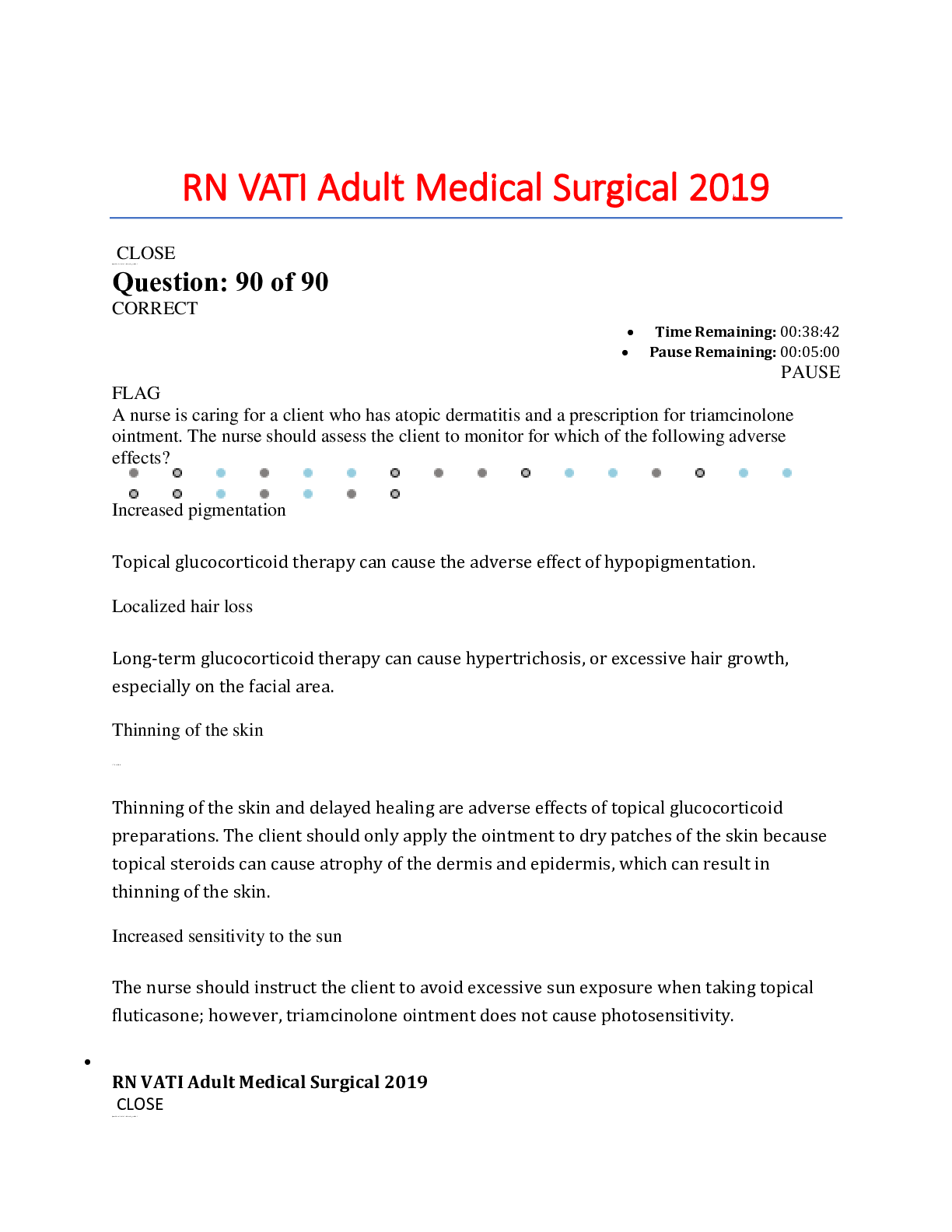
Reviews( 0 )
Document information
Connected school, study & course
About the document
Uploaded On
Mar 27, 2021
Number of pages
46
Written in
Additional information
This document has been written for:
Uploaded
Mar 27, 2021
Downloads
0
Views
184


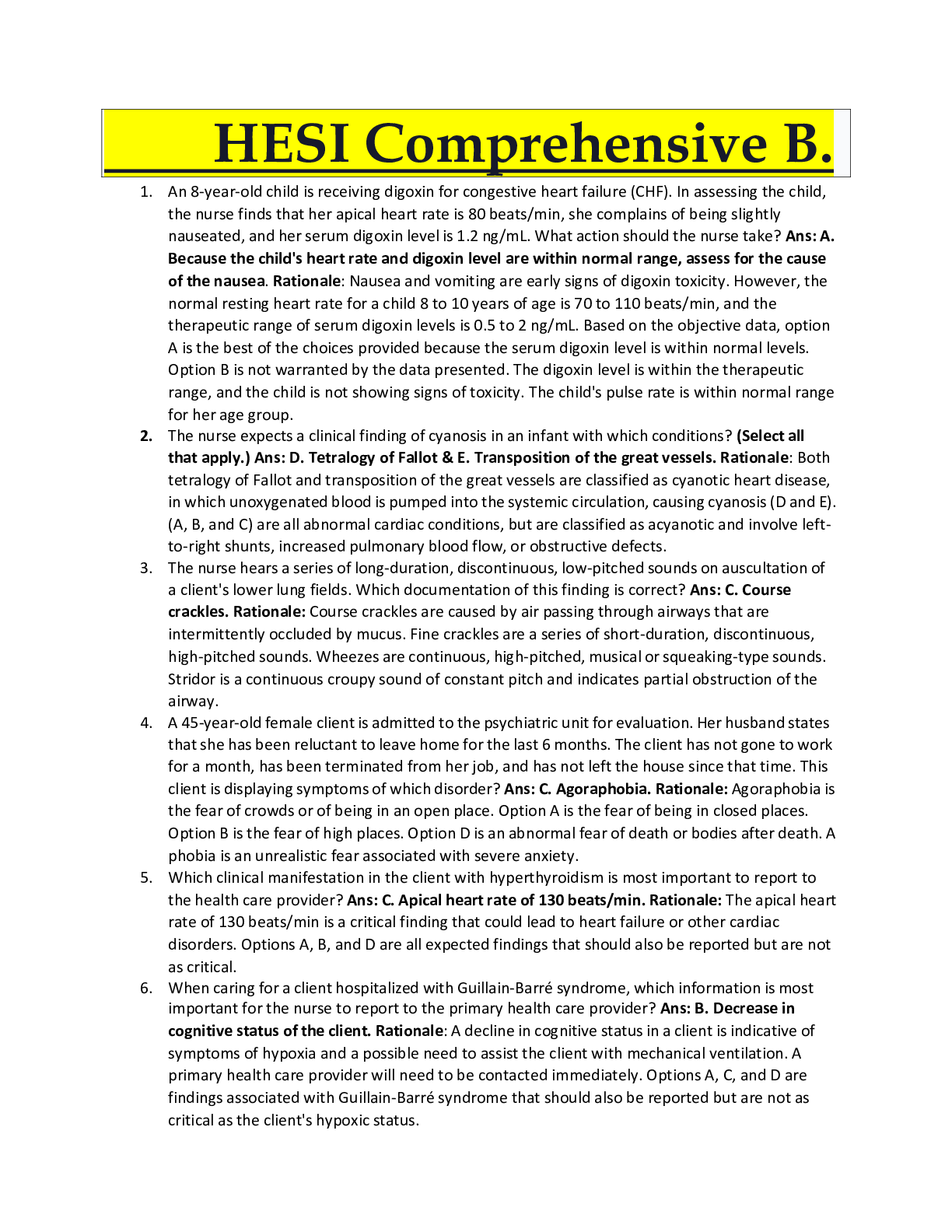
.png)
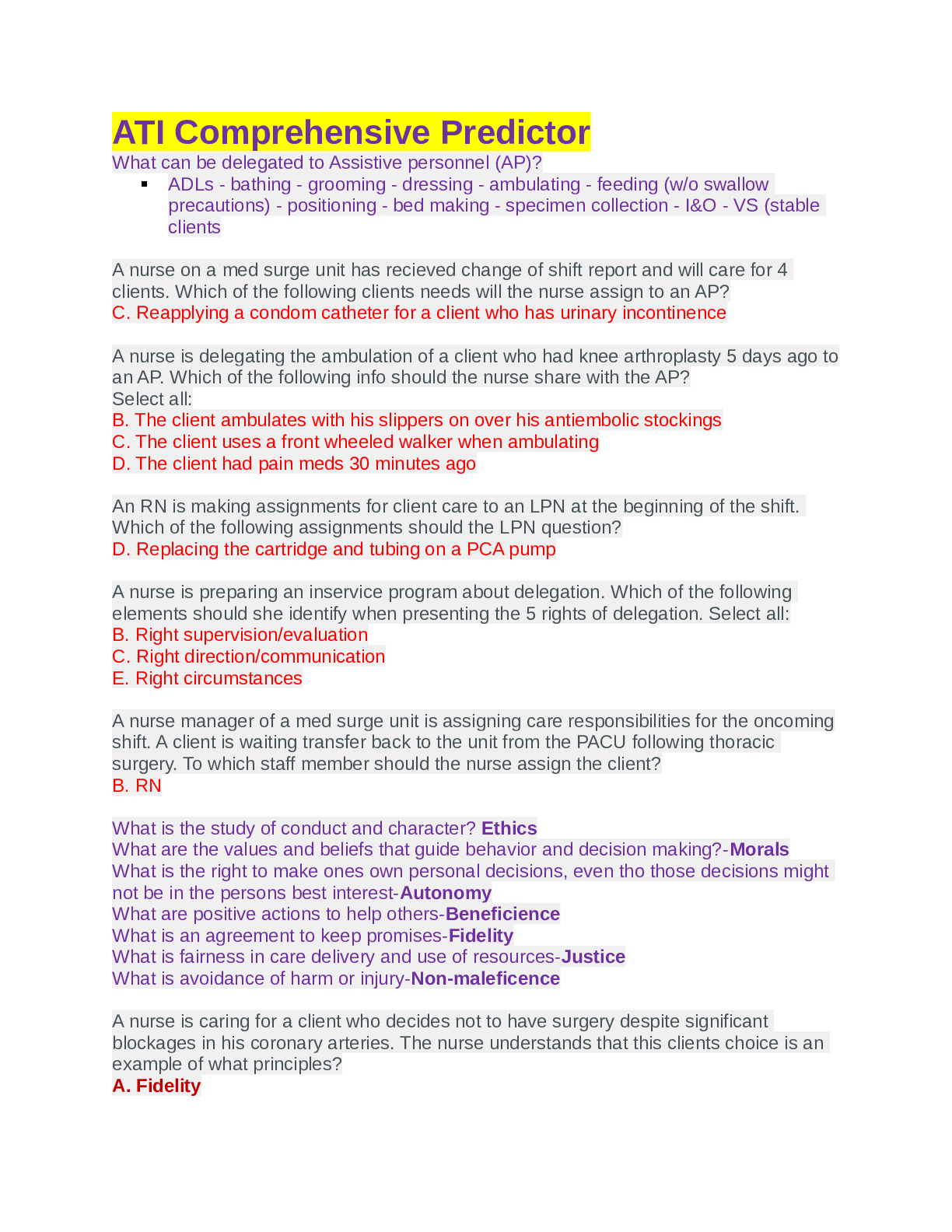
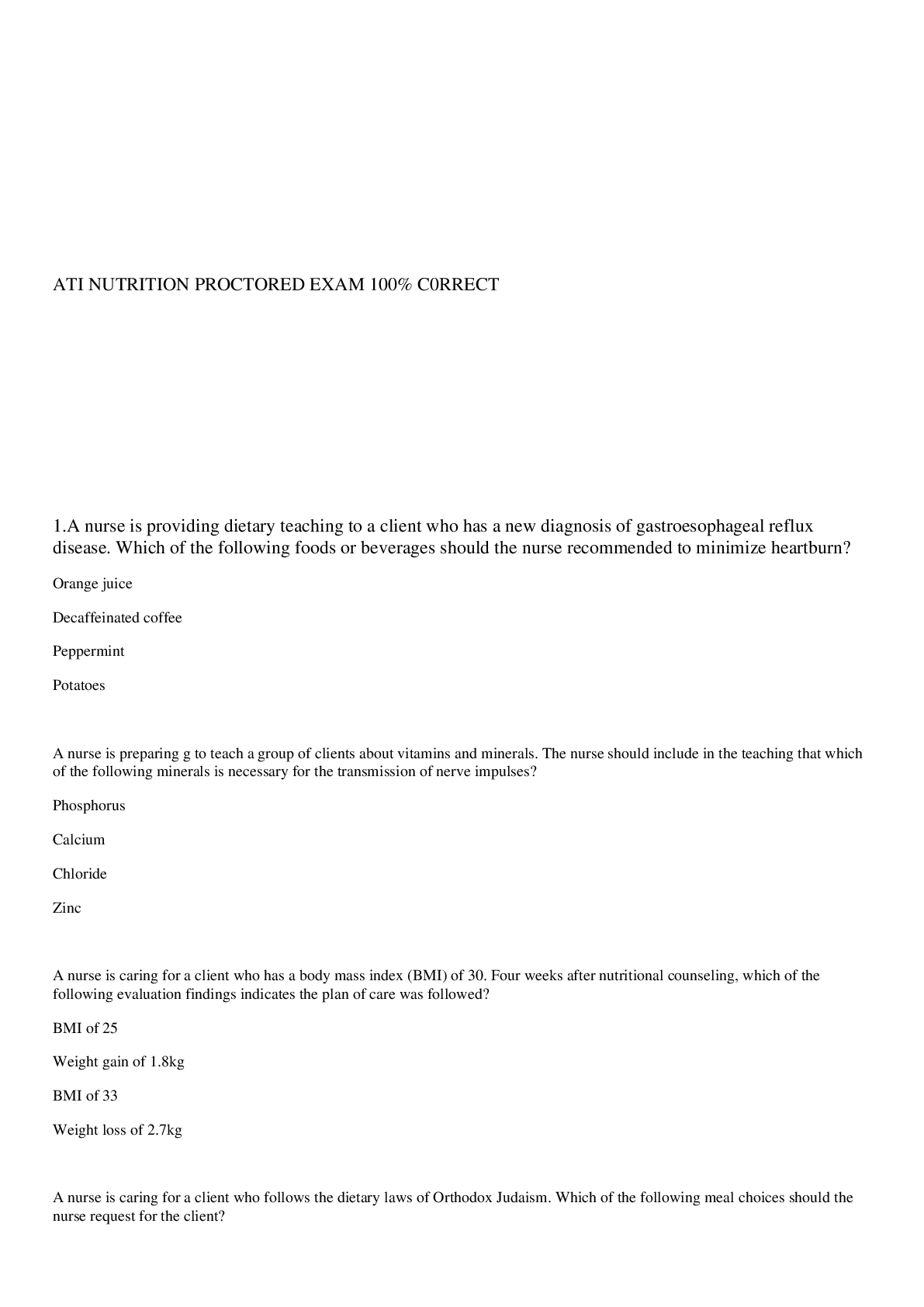


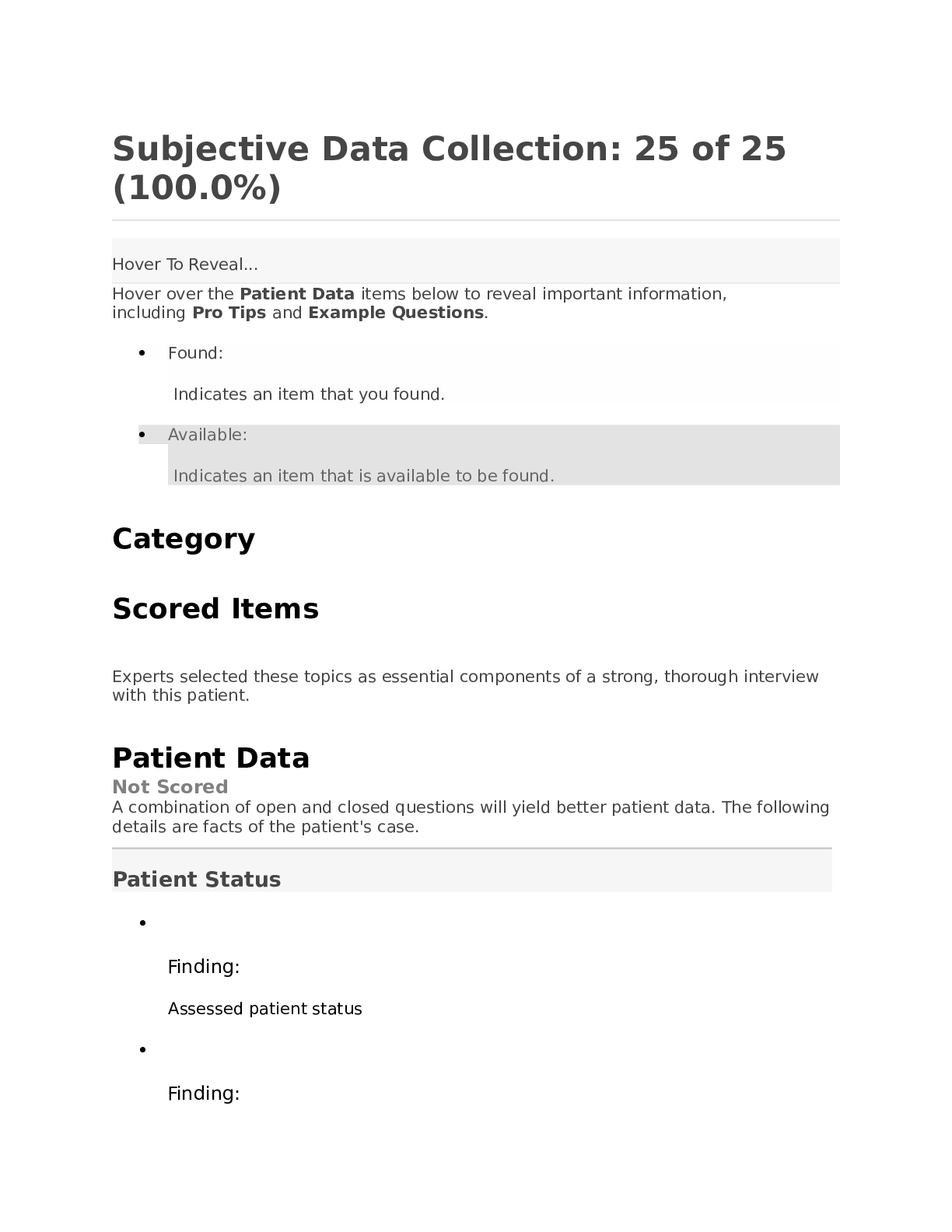


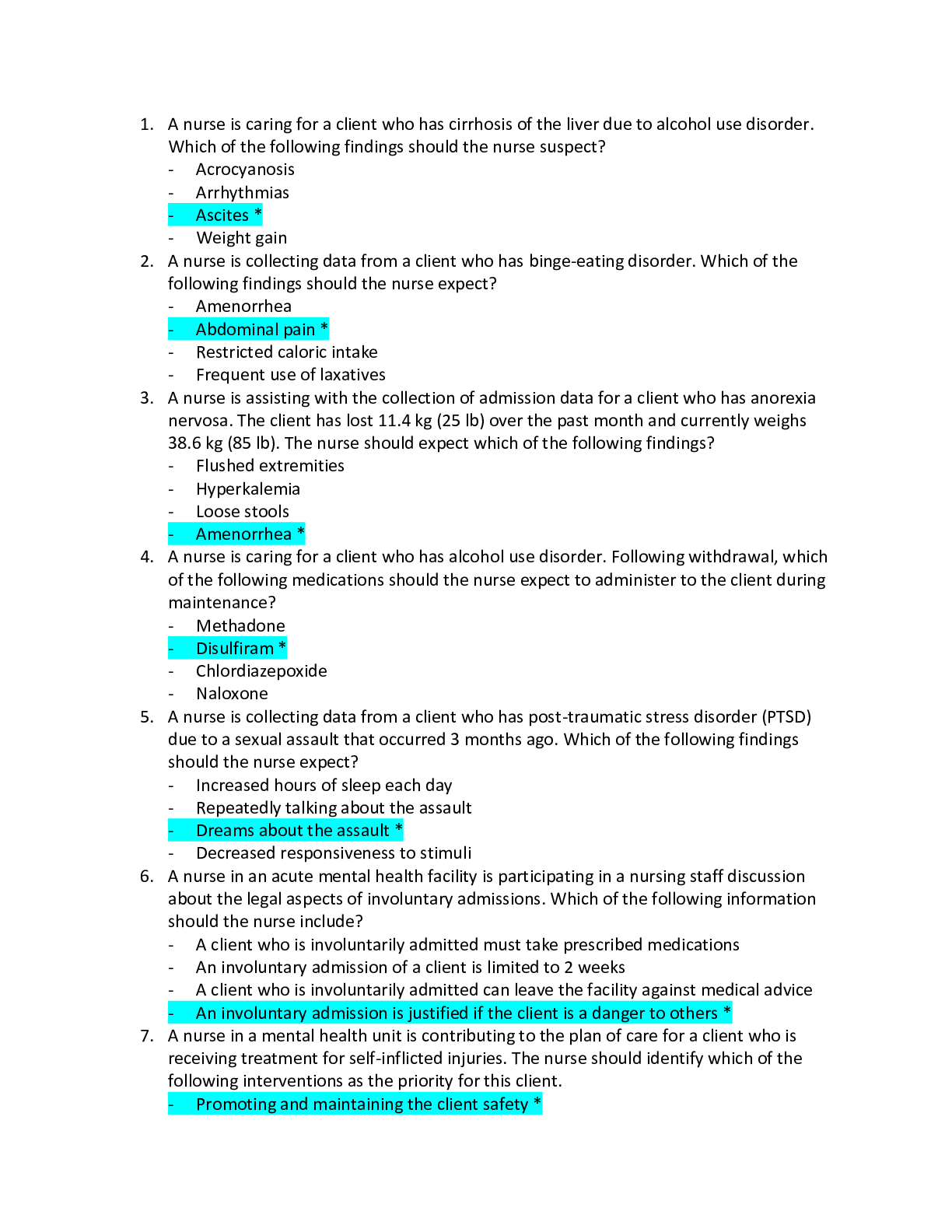
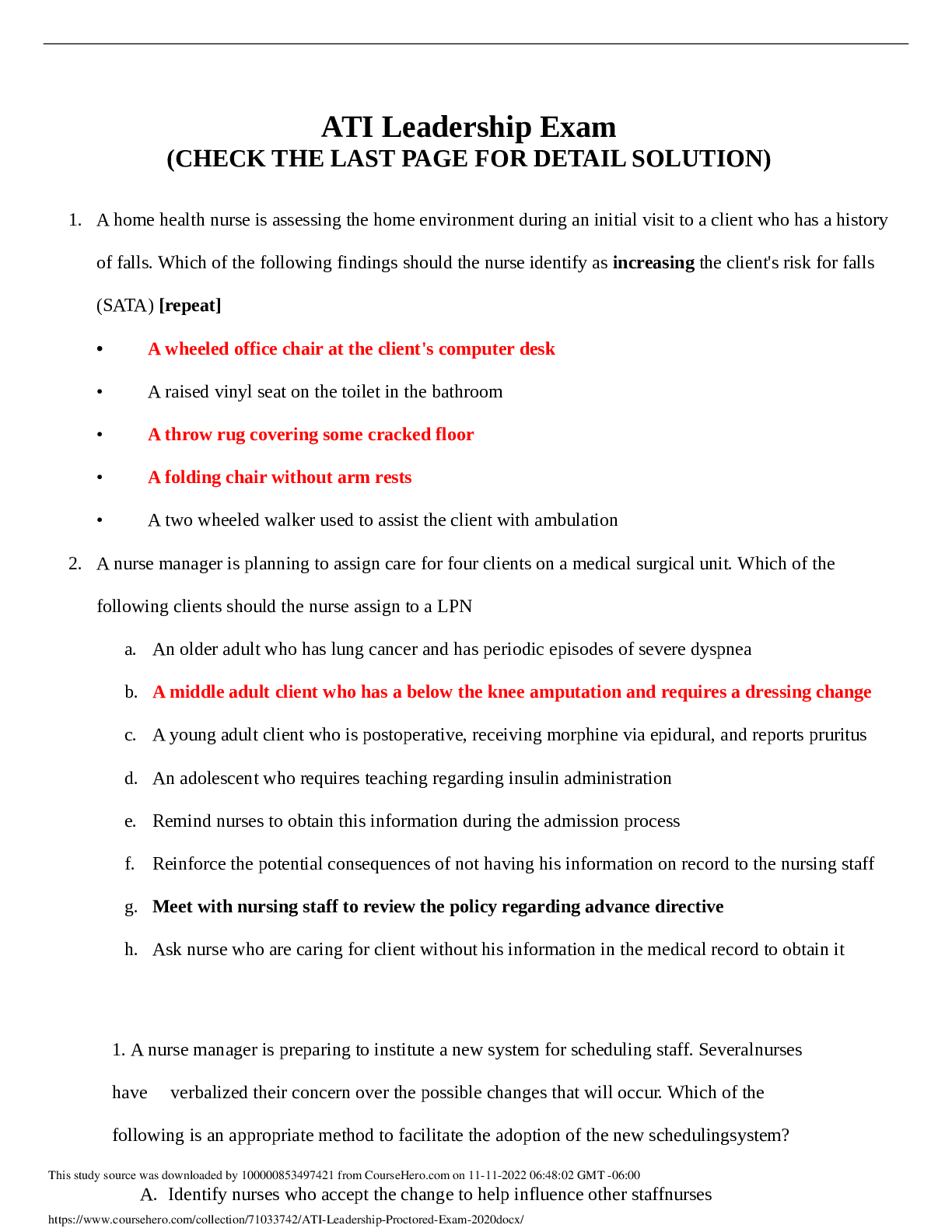


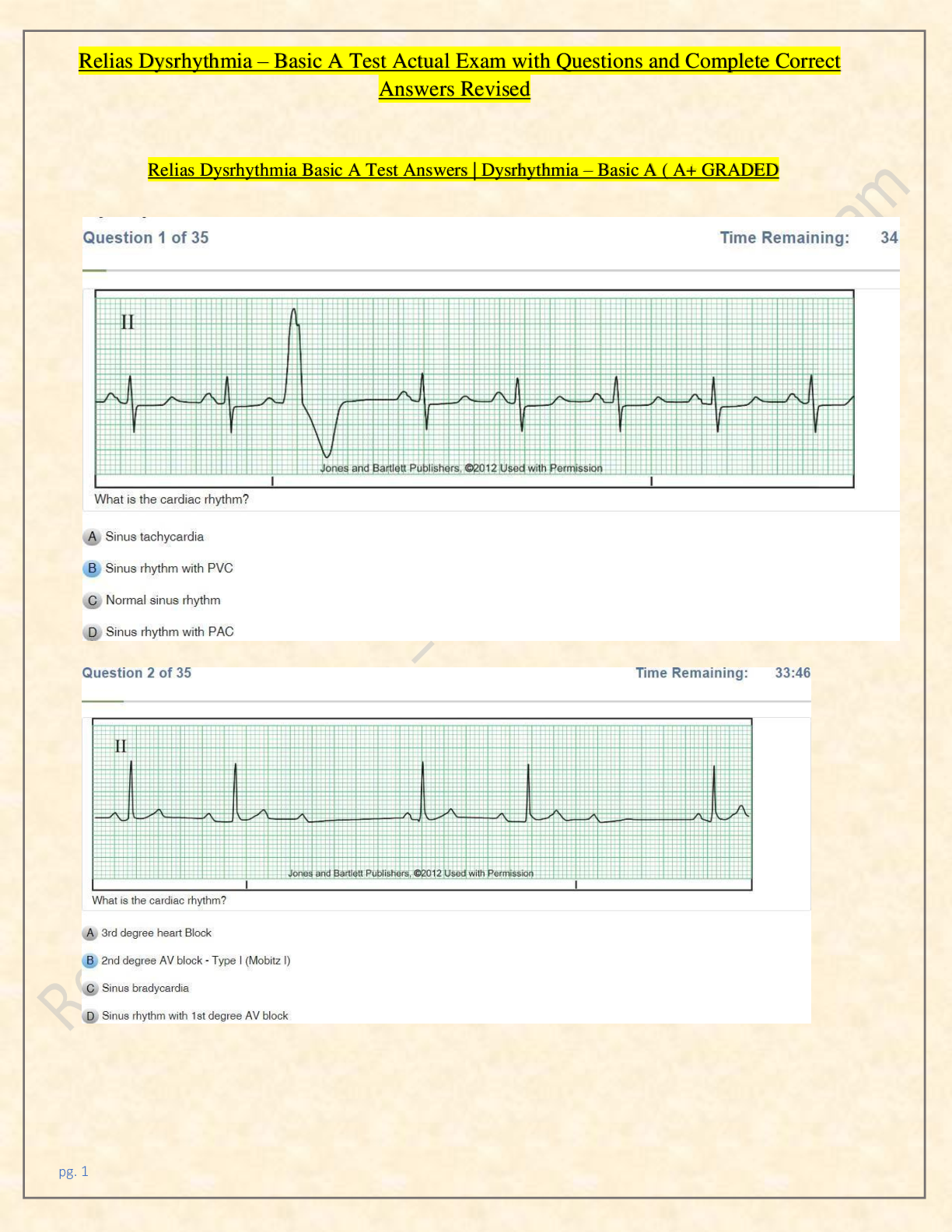
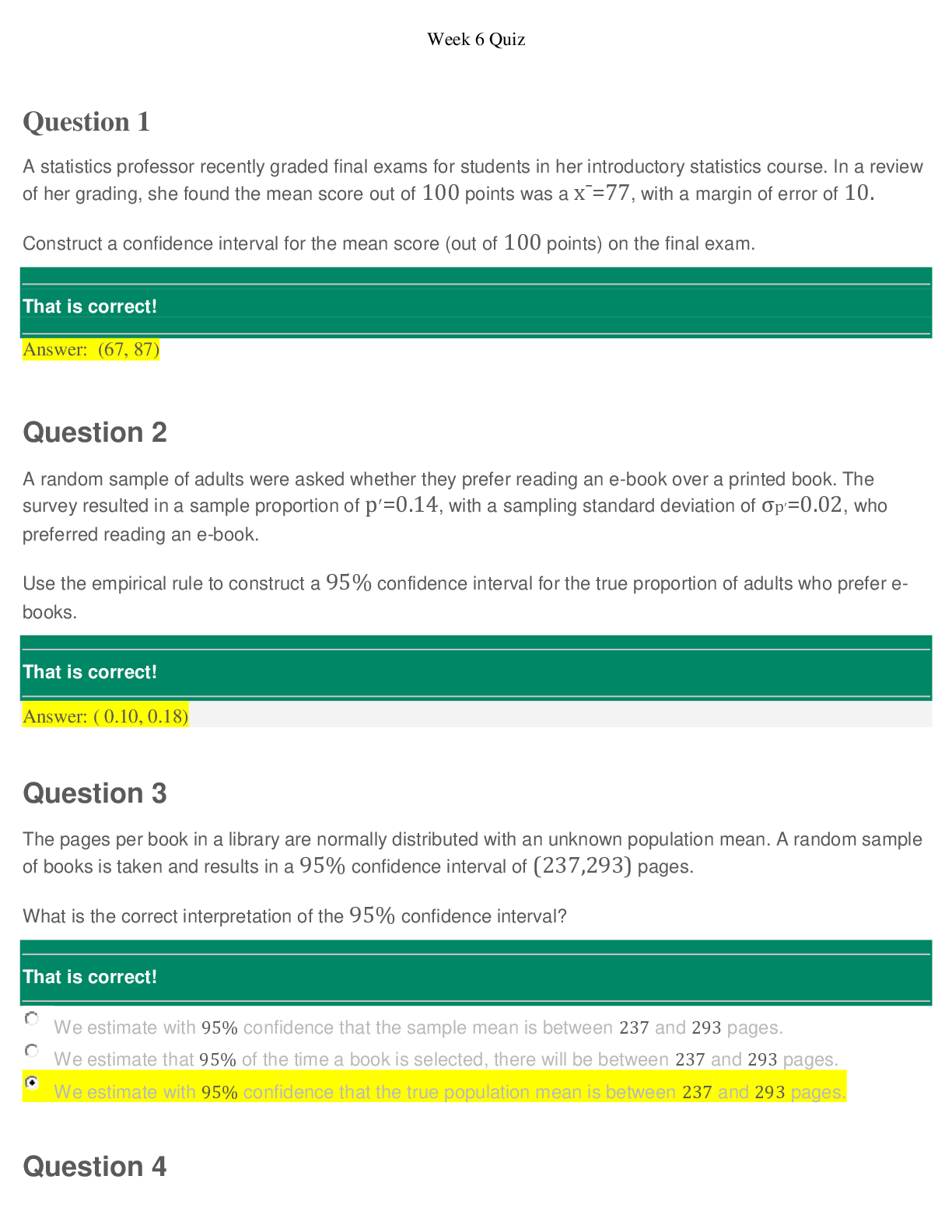

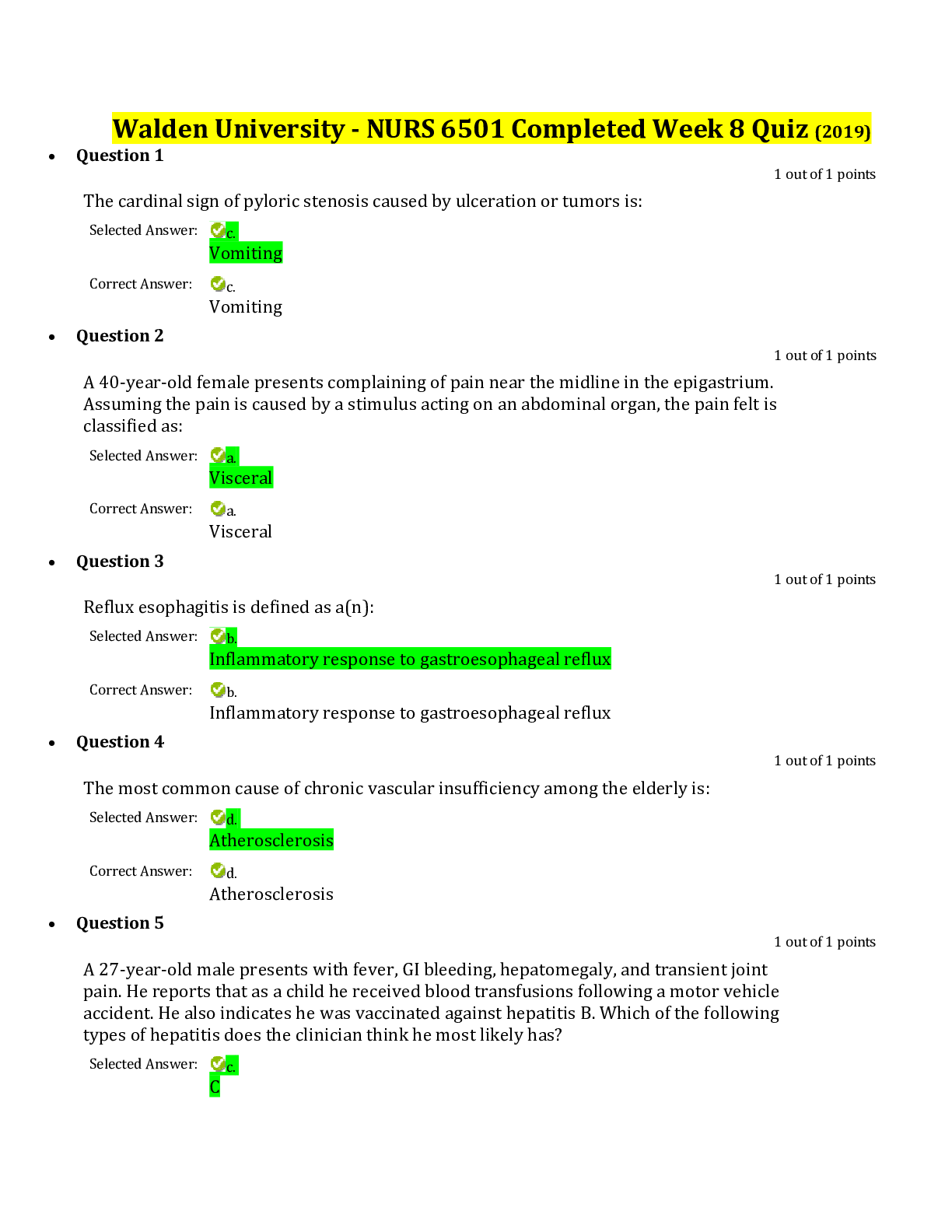
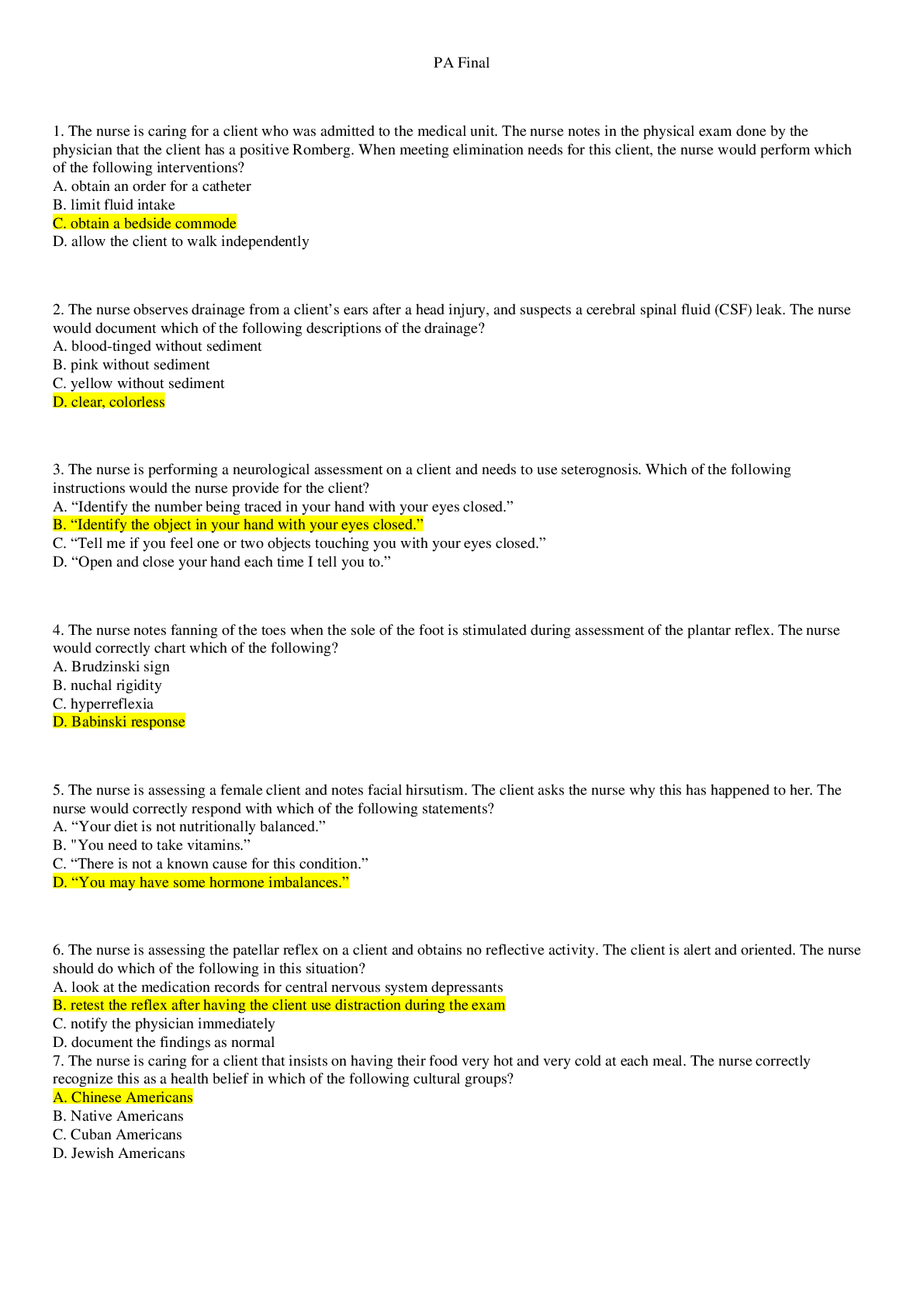
.png)

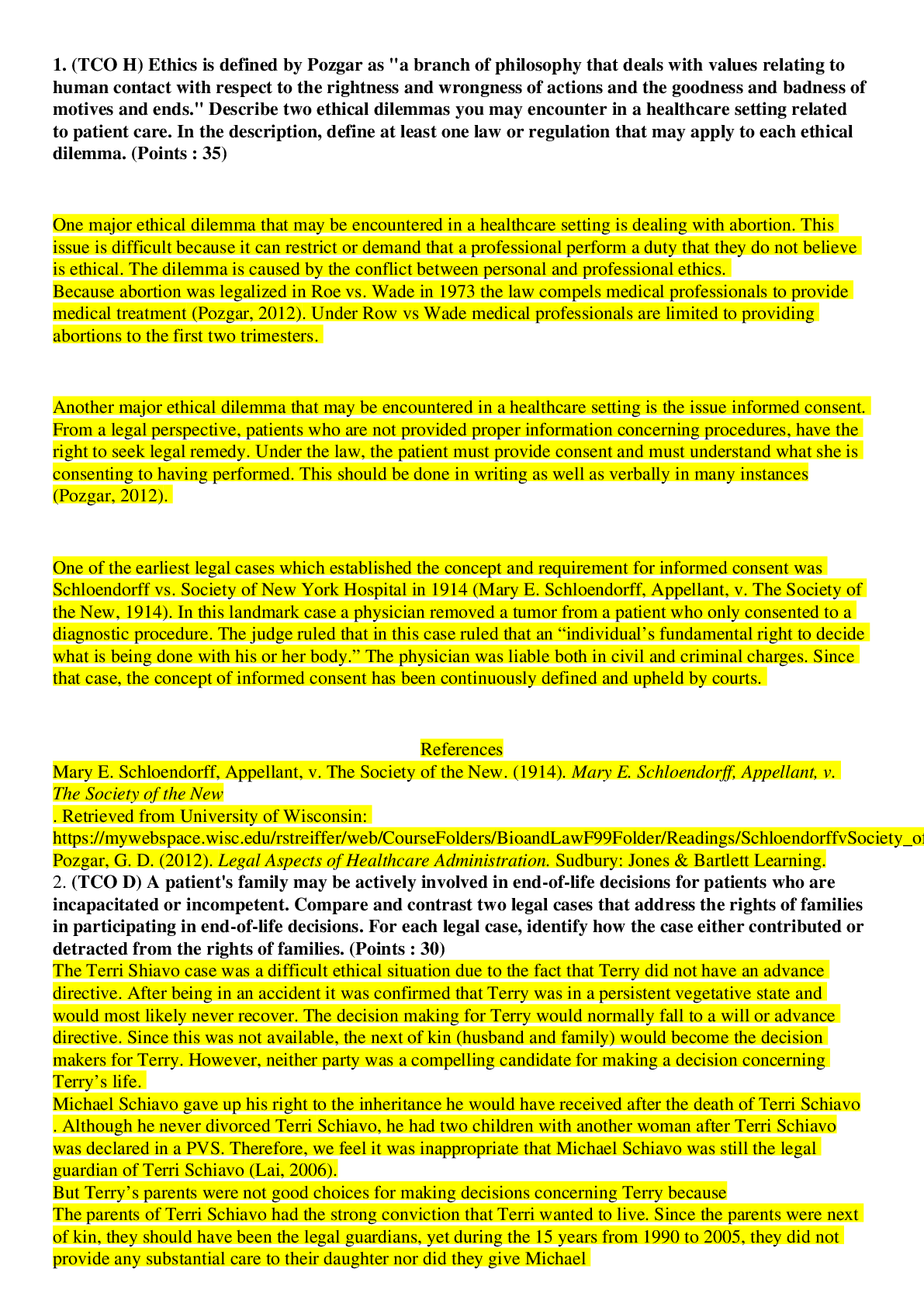

.png)

